Marburg in the state of Hesse, Germany, feels like a town that popped out of an old leather-bound book full of witches, and tailors, and cobbler’s wives, and magical creatures. You’ll find crooked houses, winding stone stairs, whimsical gargoyles, and meandering cobblestone paths, like something in a dream.
As a matter of fact, this is the very town that inspired the Brothers Grimm to collect and save the old tales of German folklore that we know today as Grimm’s Fairytales!
There is no shortage of things to do in Marburg – one of the prettiest and most enchanting medieval towns in Germany.
Here’s your ultimate Marburg travel guide – whether you want to stroll through the Old Town, visit historical Marburg attractions like the Landgravenschloss, or discover the dozens of hidden gems in this city. I know you will be as charmed by this place as I was!
1. 🏰 Marburg Castle: The Crown Jewel of Marburg Altstadt (Old Town)
Towering over Marburg Altstadt (Old Town), you can’t help but notice Marburg Castle (Landgrafenschloss) a 13th century defensive fortress that defines the skyline. It became a lavish residence for the powerful Landgraves of Hesse. Today it houses the Marburg Museum for Cultural History and provides the best photo spot in Marburg with gorgeous panoramic views of the town and its surroundings from the massive stone terrace.

📜 Early History: From Wooden Fort to Mighty Castle
The hill and those long beautiful views made this a perfect strategic location, and a prime spot to build a defensive stronghold. It started out as a wooden fort in the 11th century, and 200 years later Landgrave Henry I of Hesse ordered the construction of a strong and impressive stone castle.
Subsequent generations of Landgraves continued to expand and embellish the castle to advertise their wealth and stature.
⛪️ The 13th Century Chapel of the Landgraves
Landgrave Henry II, Henry I’s son, added the magnificent “Schlosskapelle” (castle chapel) in 1288. This exquisite space, adorned with stunning medieval frescoes, served as a place of worship for the Landgraves and their court.
You’ll be able to walk through it during your visit to the museum. Take special note of the tile floor which is really beautiful and ancient.
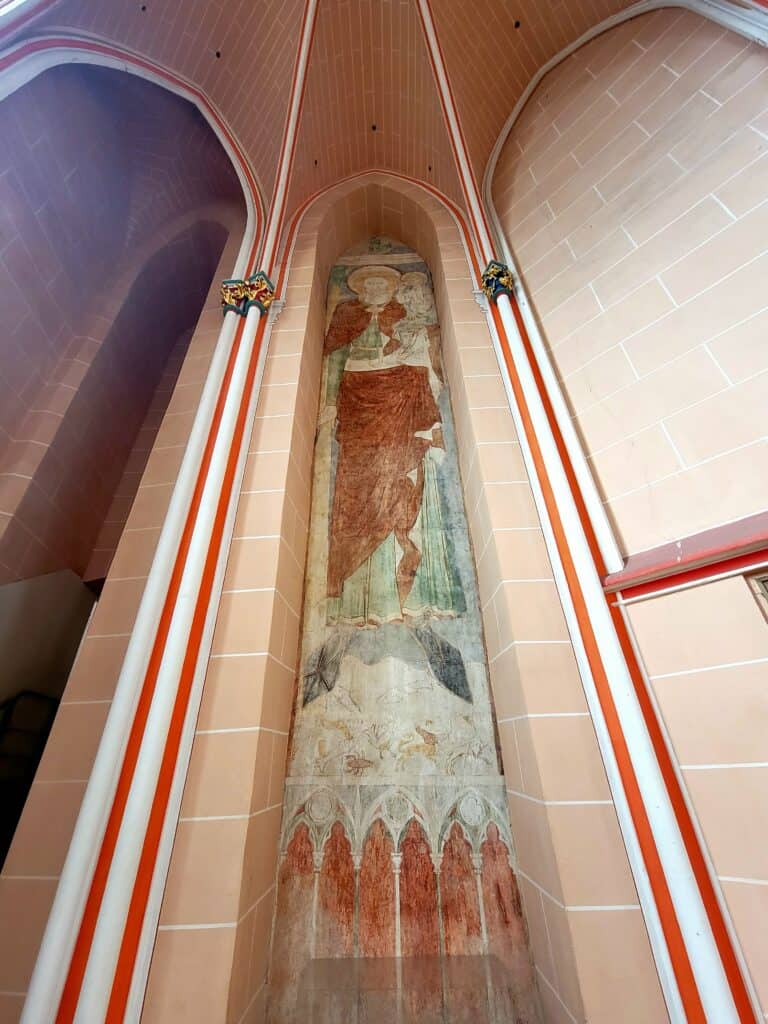
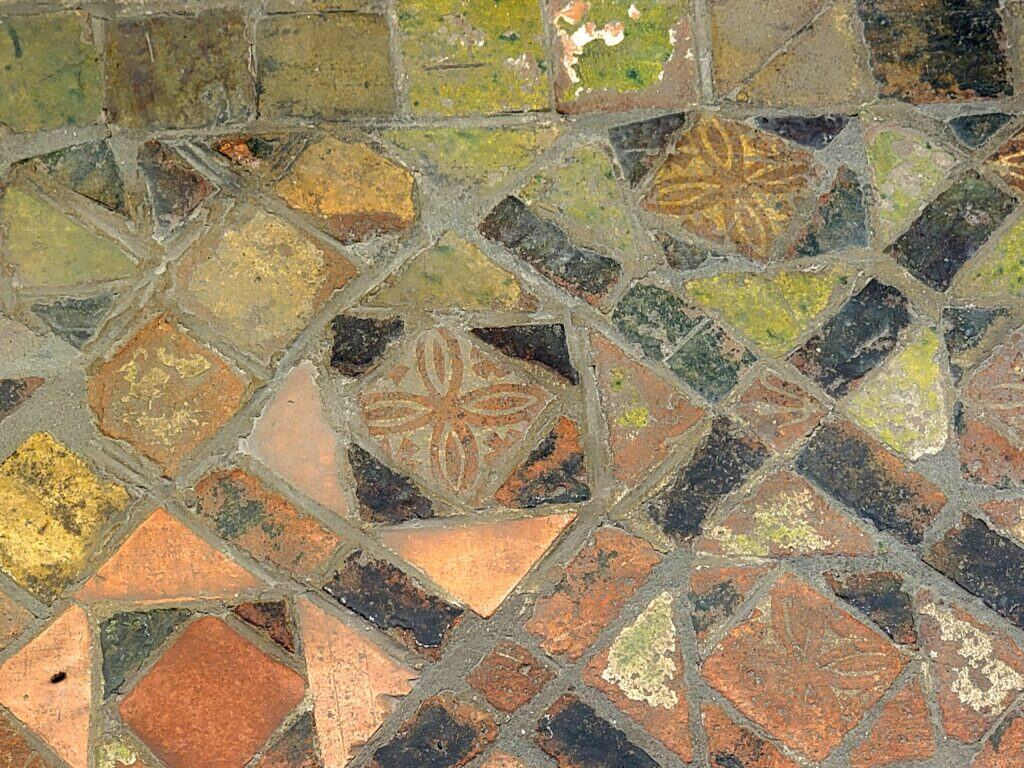
📖 The Marburg Colloquy: When Martin Luther Debated Religion Here
The Landgrafenschloss also staged a significant religious and historical event. In 1529, it played host to the famed “Marburger Religionsgespräch” (Marburg Colloquy). Philip I of Hessen wanted to bring together the leading figures of the Protestant Reformation, including Martin Luther and Ulrich Zwingli, to bridge their theological differences and create a strong Protestant coalition.
That kumbaya moment didn’t happen, because on the fifteenth of fifteen points, they disagreed. Luther said the eucharist was actually the body of Christ, and Zwingli said it was more like a metaphor. Neither would budge, but the event was historic nonetheless and there’s a huge and impressive painting of it in the castle’s museum.
🗝️ The Witches’ Tower: Marburg’s Darkest Secret

Around the back of the castle you’ll find a large circular tower called the Hexenturm (Witches’ Tower). From the 16th to the 19th century (1550 to 1866) the tower was used as a prison, and many women who were falsely accused of witchcraft were held and tortured there in the 16th and 17th centuries.
The exact number of executions and deaths that happened in the tower are unknown. The small barred cell windows are still visible today as you can see. It was one of those sad moments of reality realizing the amount of human suffering that happened in this beautiful place.
💡 Did You Know? Germany saw over 25,000 people executed for witchcraft between the 16th and 18th centuries. Marburg’s Hexenturm was one of the many sites where these tragic events occurred.
🛠Renovation of the Castle
In the 18th century, the Landgraves relocated their primary residence elsewhere, and the castle gradually fell into disrepair. By the 19th century people had begun to take an interest again in the castle, and restoration efforts began in earnest with the goal of preserving the castle’s history and architecture.
By the 20th century a large part of the complex was given over to the university, and after further restoration it now houses the Marburg University Museum for Cultural History.
🕙 Visiting Information for Landgrafenschloss
The castle is open from 10am-4pm Tuesday through Sunday, and is closed on Mondays.
🚶 Best Way of Getting to the Castle
To reach the castle, you’ll definitely get your steps in! There are two ways up to the top. One is primarily stairs, and the other is a fairly steep cobblestone street.
We went up twice, once each way. The slope is probably a little bit easier, but if it were raining and the cobblestones were wet I’d definitely do the stairs.
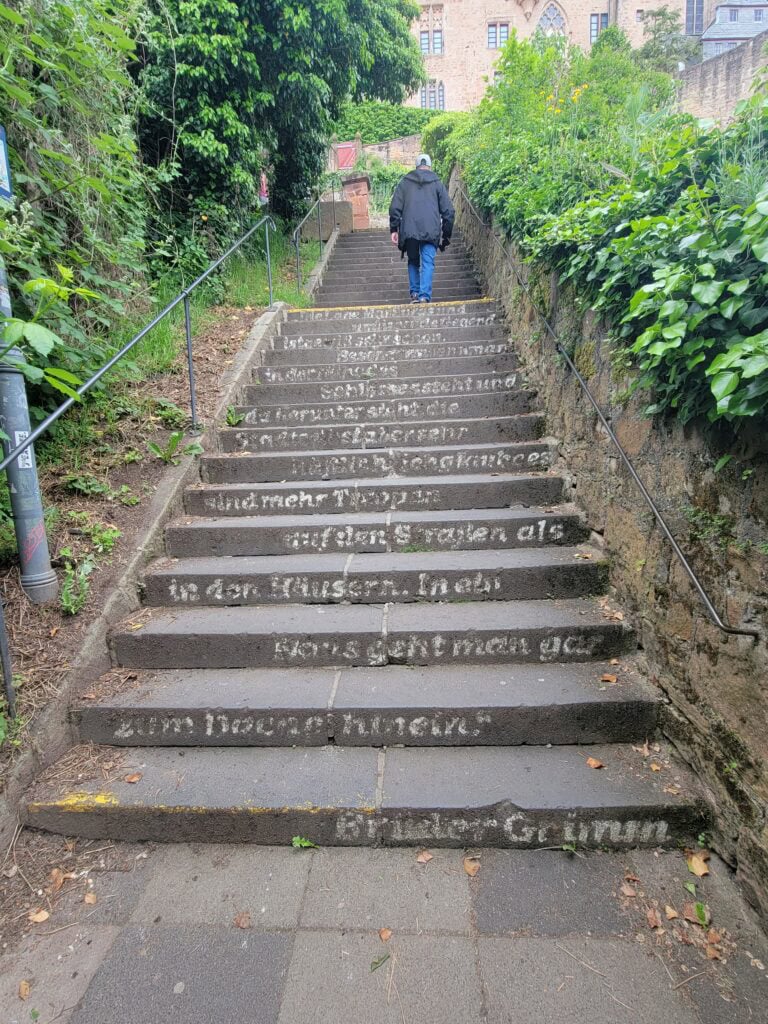
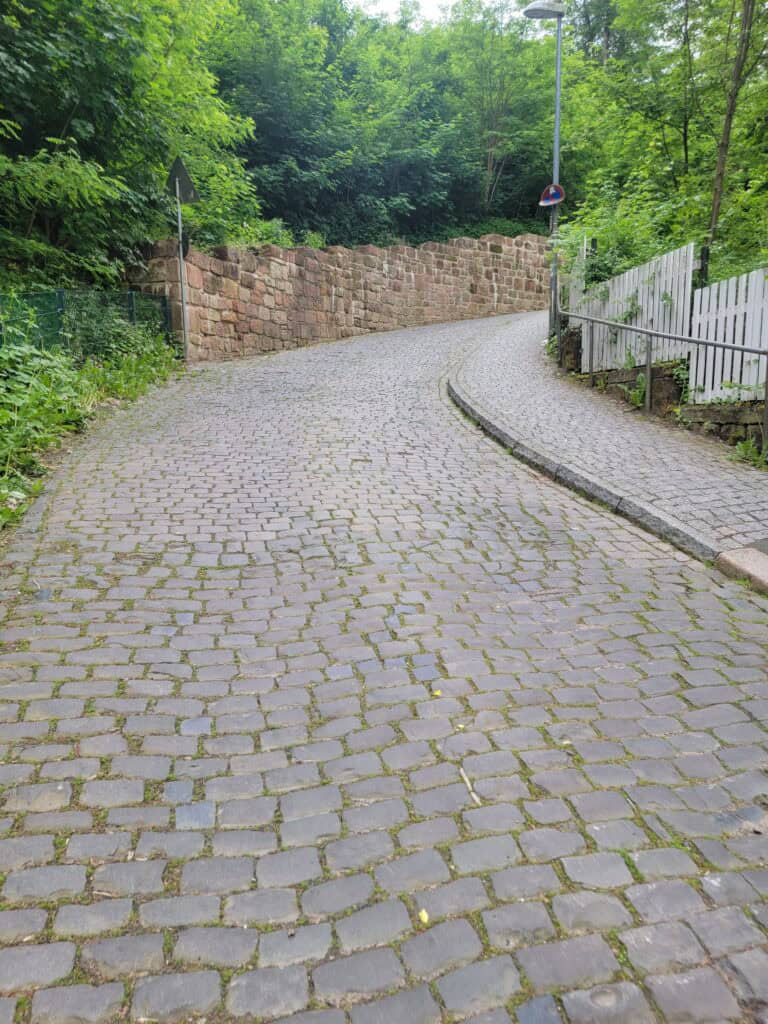
At the top, you’ll reap the reward with a really stunning view of the Old Town of Marburg, and the newer buildings further in the distance. You’ll be able to see the Market Square with the Town Hall, and several impressive church steeples.
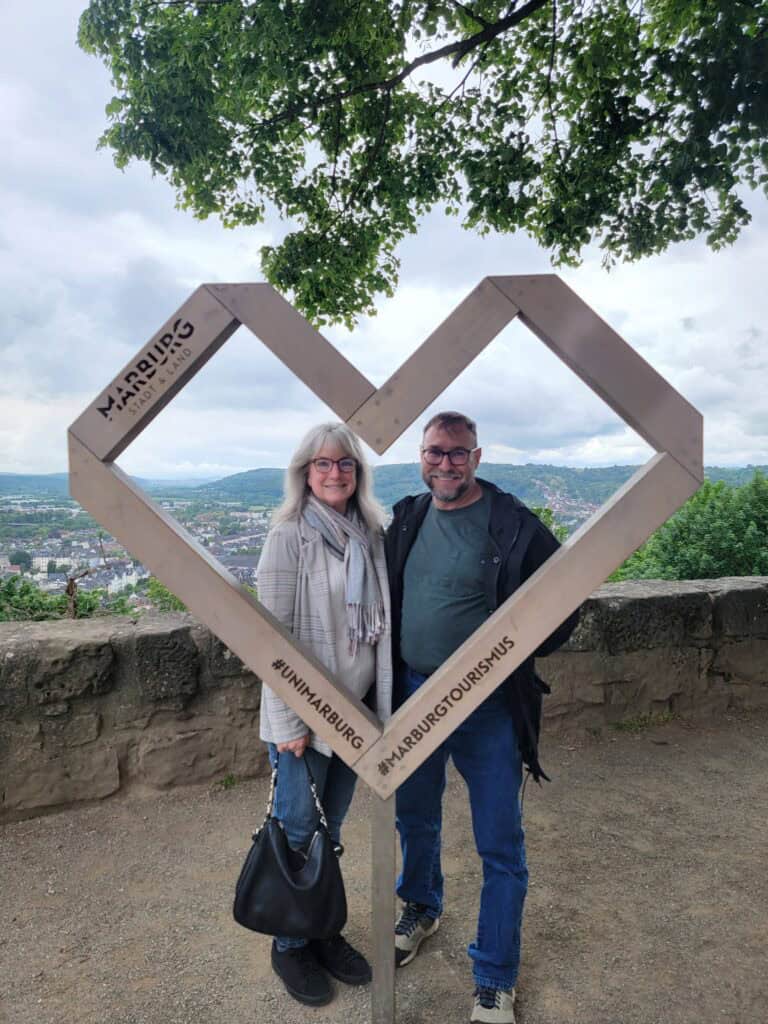
There are also large binoculars so you can zoom in to examine the architecture from on high. It will cost you €1 – either via €1 euro coin or two 50 cent pieces.
Don’t miss the cute social media photo opp with the cute wooden heart!
✅ Explore all the history and hidden gems of Marburg with this private customizable walking tour! 👑
2. The Marburg University Museum for Cultural History
The museum in the castle costs €8 (about $9) per adult ticket, and they only take cash. If you were wondering why we walked up to the castle twice (once via stairs and once via the road), now you know!
There are no cash machines near the castle, so you’ll have to walk all the way back to the Old Town to an ATM and back up again if you are knuckleheads like us and forgot to bring cash!
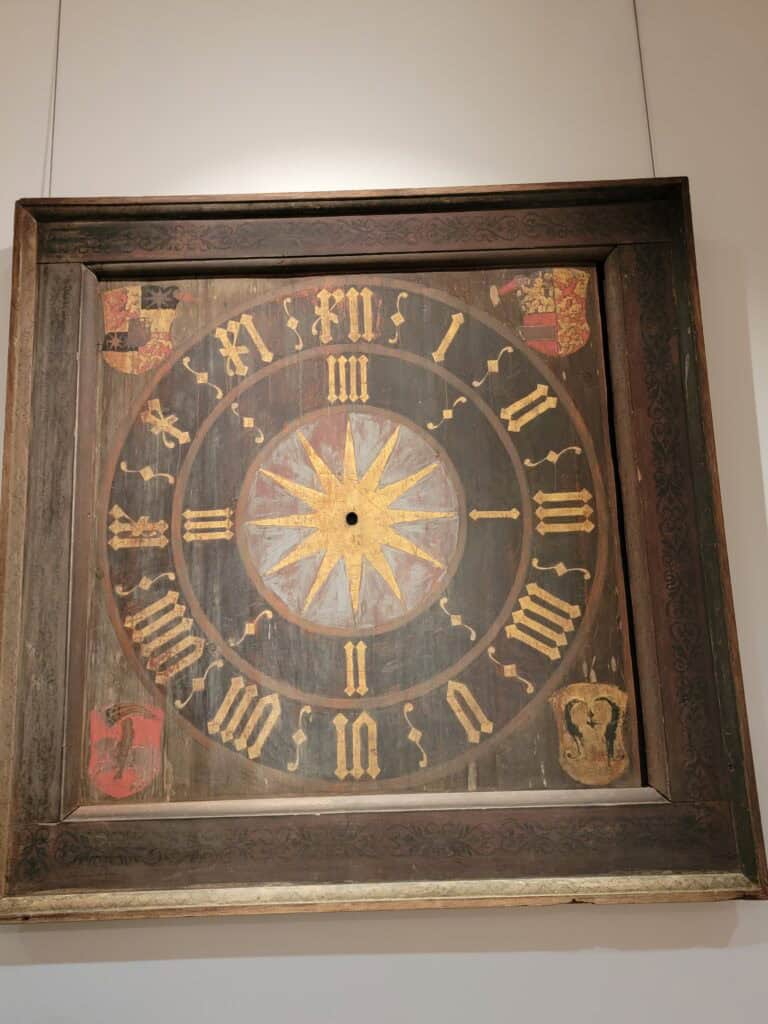
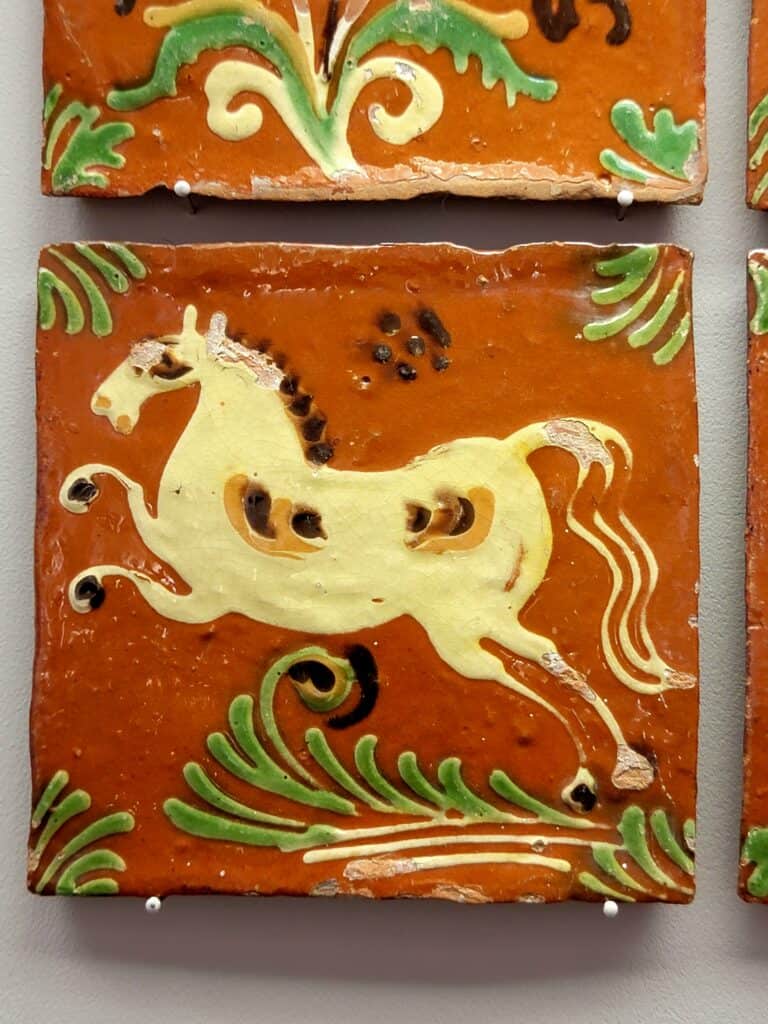
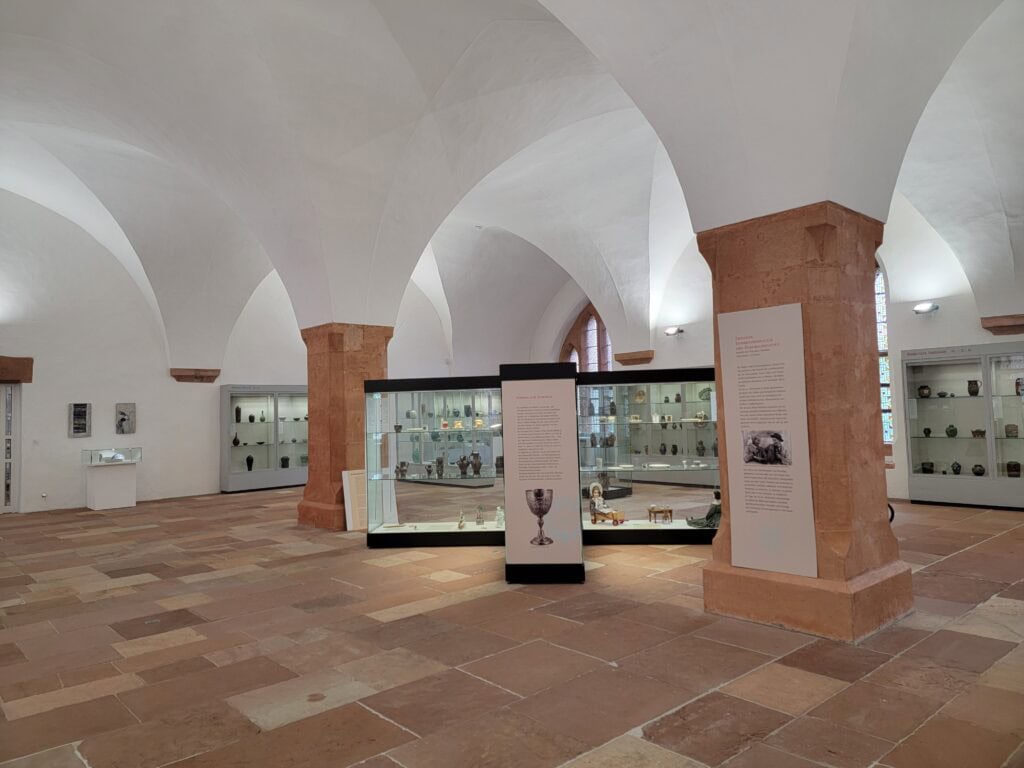
Once you’re inside, the museum houses a fairly small but very interesting selection of historical artifacts from medieval Marburg.
- Ceramics & Pottery – Marburg’s distinct ceramic style throughout the ages.
- Medieval Town Artifacts – The original clockwork from the Town Hall and the megaphone once used by the town crier!
- Preserved Castle Interiors – Walk through centuries-old rooms, complete with faded frescoes, old window seats, and a medieval banquet hall.
🚹🚺 Good to know: You will also find restrooms inside the museum.
🔗 If you’re fascinated by Marburg’s medieval history, be sure to check out the Town Hall (Rathaus)—it’s been at the heart of the city for over 500 years!
3. Phillips University: A Learning Institution That Shaped History
Biegenstraße 10, 35037 Marburg
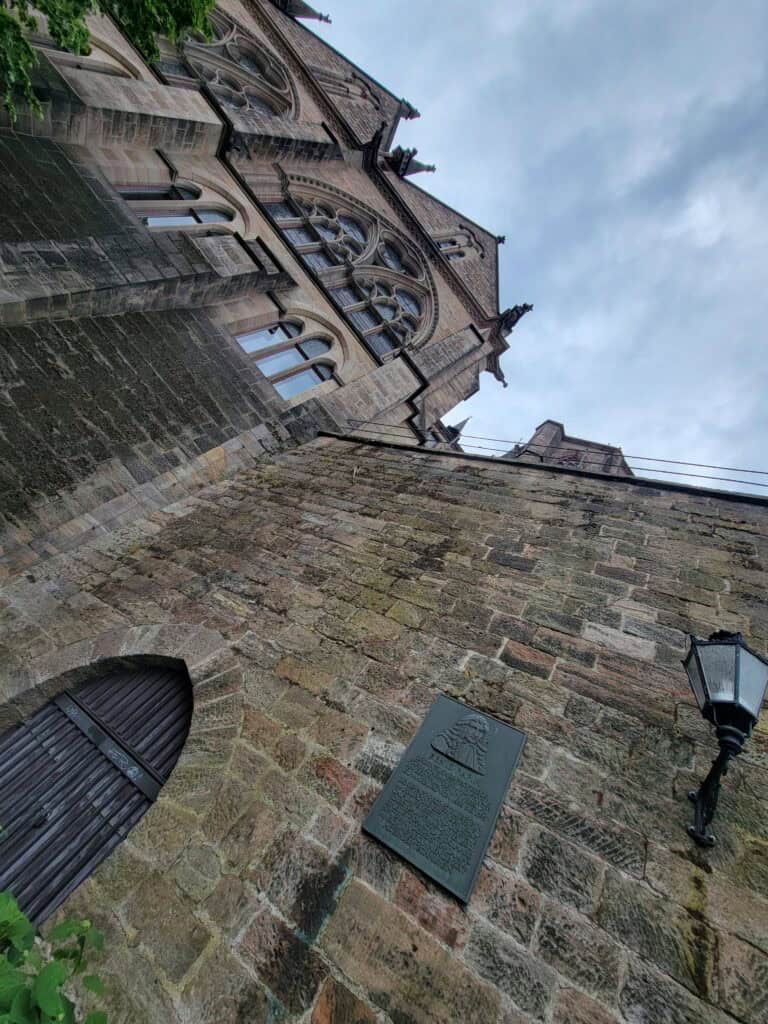
Philip I of Hesse, eager to make Marburg a center of Protestant thought, founded the university during the Reformation. It quickly became known as a seat of lively intellectual exchange which challenged the established academic order of the time.
🧑🏫 Famous Students and Faculty
Over the centuries, brilliant minds have been drawn to Marburg to study and teach here, including:
📜Jacob and Wilhelm Grimm (the Brothers Grimm) who studied law here while they collected German folklore. The Grimm Brothers’ papers and first editions of their fairy tales are part of the university’s rare book collection!
💉 Emil von Behring – Nobel Prize-winning pioneer of immunology.
📚 Martin Heidegger – Controversial philosopher who later joined the Nazi Party.
⚖️ Johann Georg Gödelmann – A legal scholar whose writings fueled Europe’s witch trial hysteria.
💡 Dark History: Some university faculty members including Gödelmann played a direct role in legal justifications for witch trials, leading to the imprisonment, torture, and deaths of many innocent women.
🏛️ A University City with Modern Energy
Today, students make up nearly half of Marburg’s population, bringing a fun, youthful, and energetic vibe. Expect to find:
- Trendy cafés & budget-friendly eateries
- Posters everywhere advertising concerts, events, and student activities
- A mix of medieval & ultra-modern architecture
📍 One of my favorite hidden gems in Marburg is the university chapel, which has a stunning wooden ceiling & original polychrome paint. It is free to enter and look around.
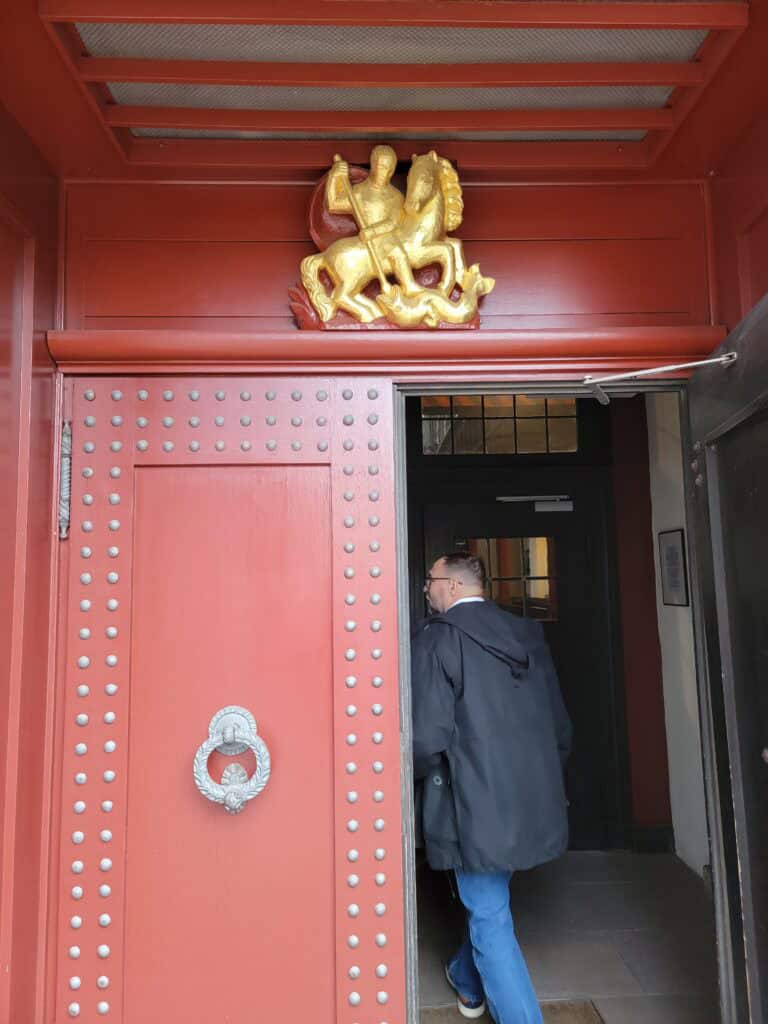
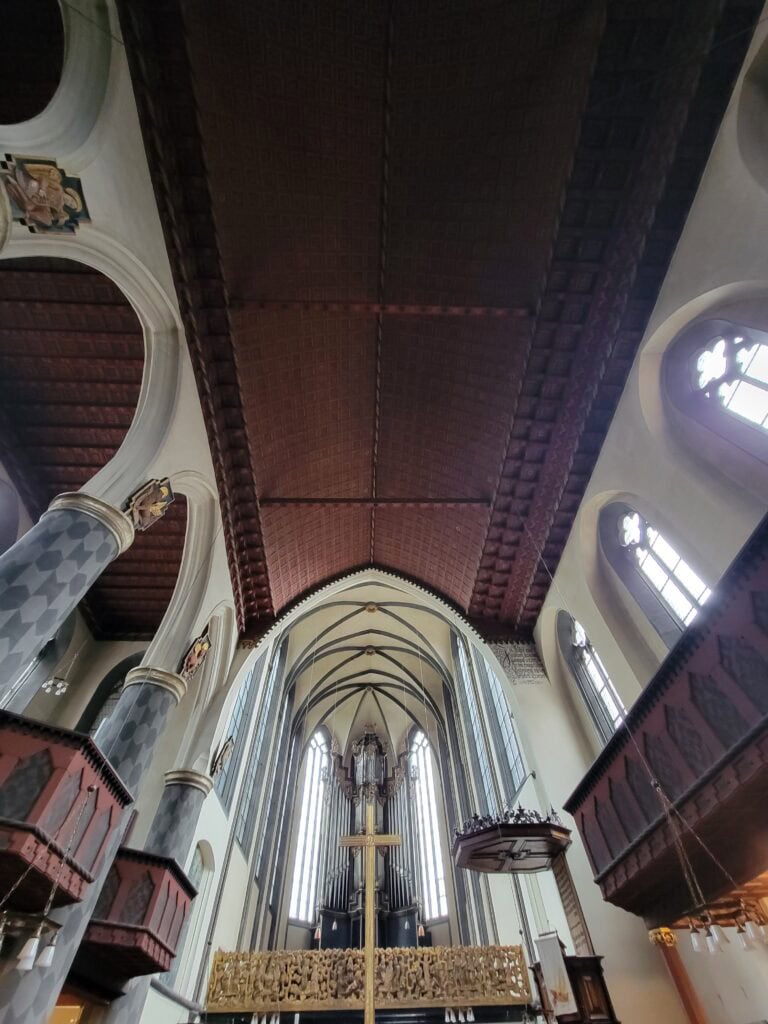
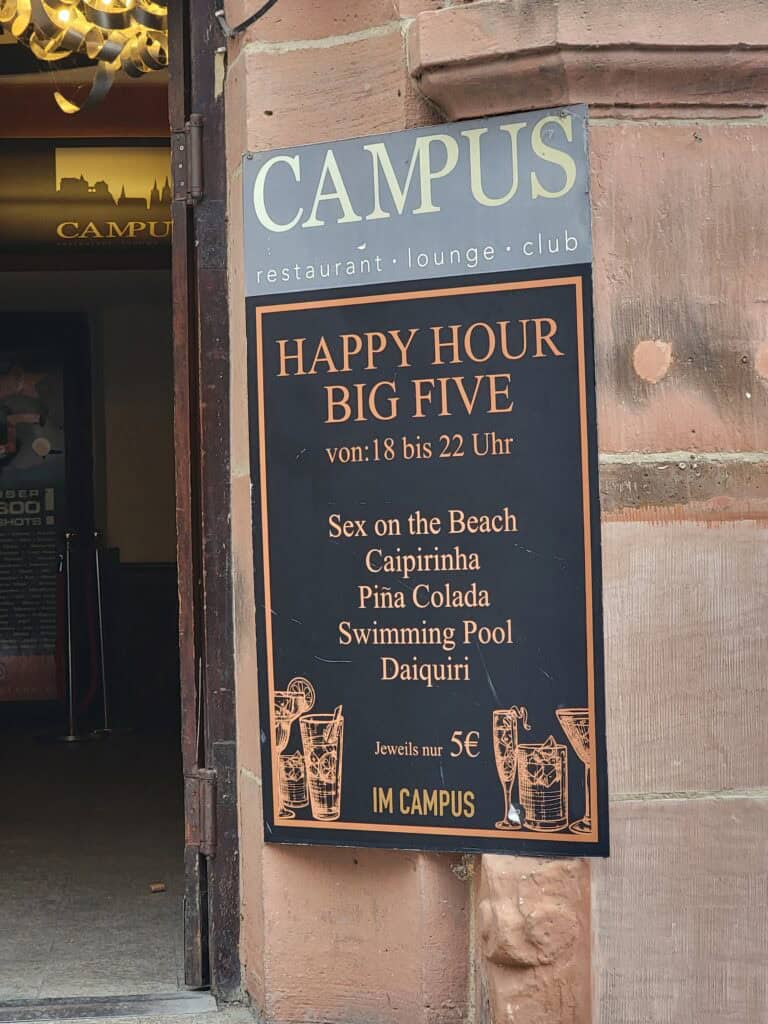
🔗 Want more medieval history? Marburg Castle played a key role in the Protestant Reformation—be sure to visit the site of the historic Marburg Colloquy!
4. Marburg Town Hall (Rathaus): The Center of Old Town
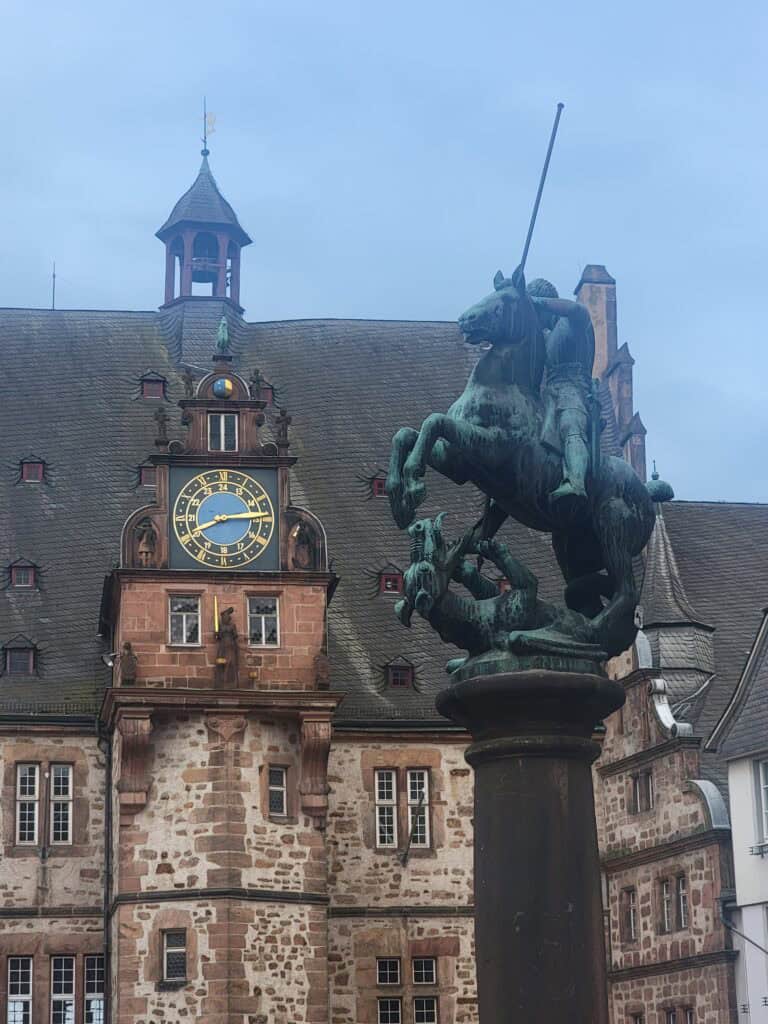
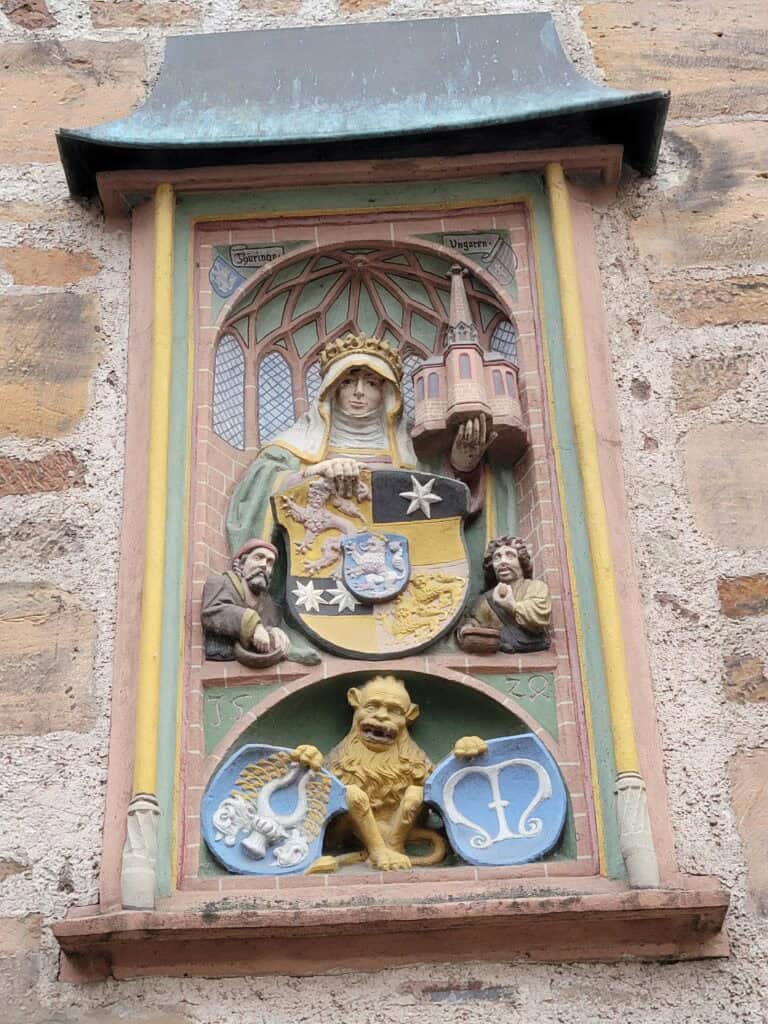
In the heart of the Marburg Altstadt, it’s easy to imagine the bustling market square throughout the last 500 years. Timber-framed buildings with their distinct facades face the square, and the Rathaus, Marburg’s historic town hall, takes center stage with a unique blend of Gothic and Renaissance architecture and a fanciful and intricate clock tower.

And believe it or not, this 16th century building is the “new” Town Hall. The first one was destroyed by fire in 1514, but citizens immediately made plans and rebuilding was underway about 12 years later.
🤭 The Rathaus’ tower is over 130 feet tall, and features a clock with a golden rooster that “crows” on the hour and tries very hard to flap its wings! Don’t miss it, trust me!
🐒 And if you’re like me, you’ll get a good chuckle at the “lion” on the coat of arms over the door. The legend goes that the carver tasked with the job had never actually seen a lion… but he had seen a monkey!
🏛️ Can You Go Inside?
Yes! While the Rathaus is still an active government building, parts of it are open to the public. Inside, you’ll find:
- Historical exhibits showcasing Marburg’s history.
- The magnificent stone hall, with Renaissance plasterwork & stained glass windows.
🔗 After visiting the Rathaus, cross the square to the Fachwerkhaus, one of Marburg’s most photogenic medieval buildings!
5. Fachwerkhaus: Marburg’s Iconic Half-Timbered House
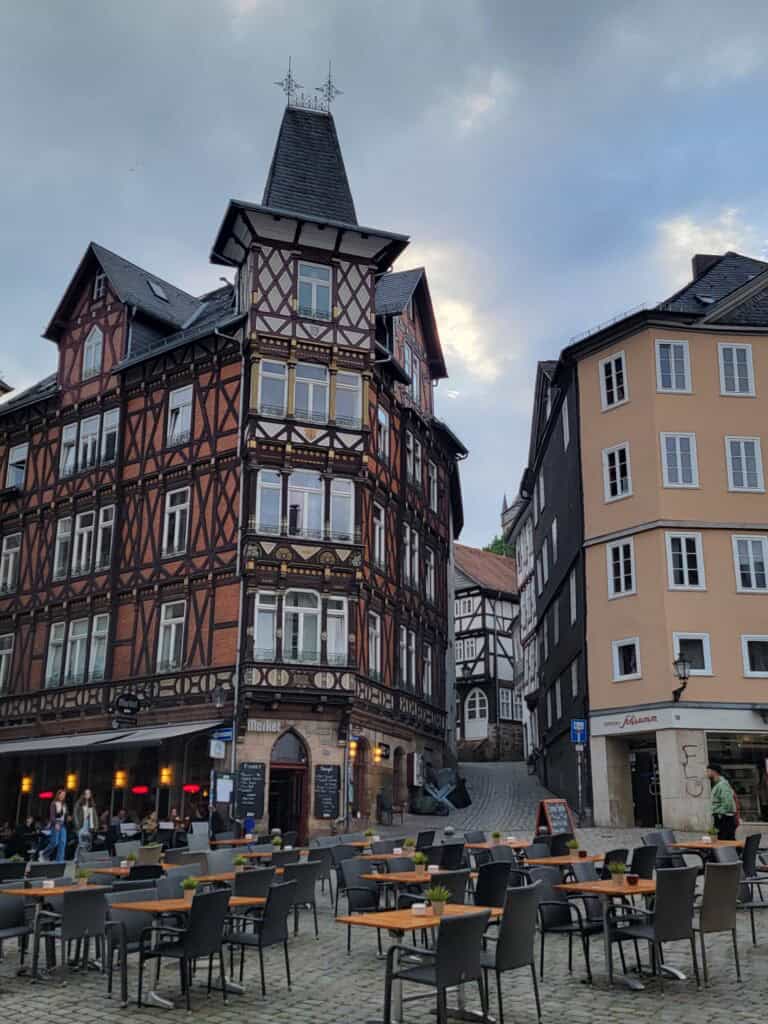
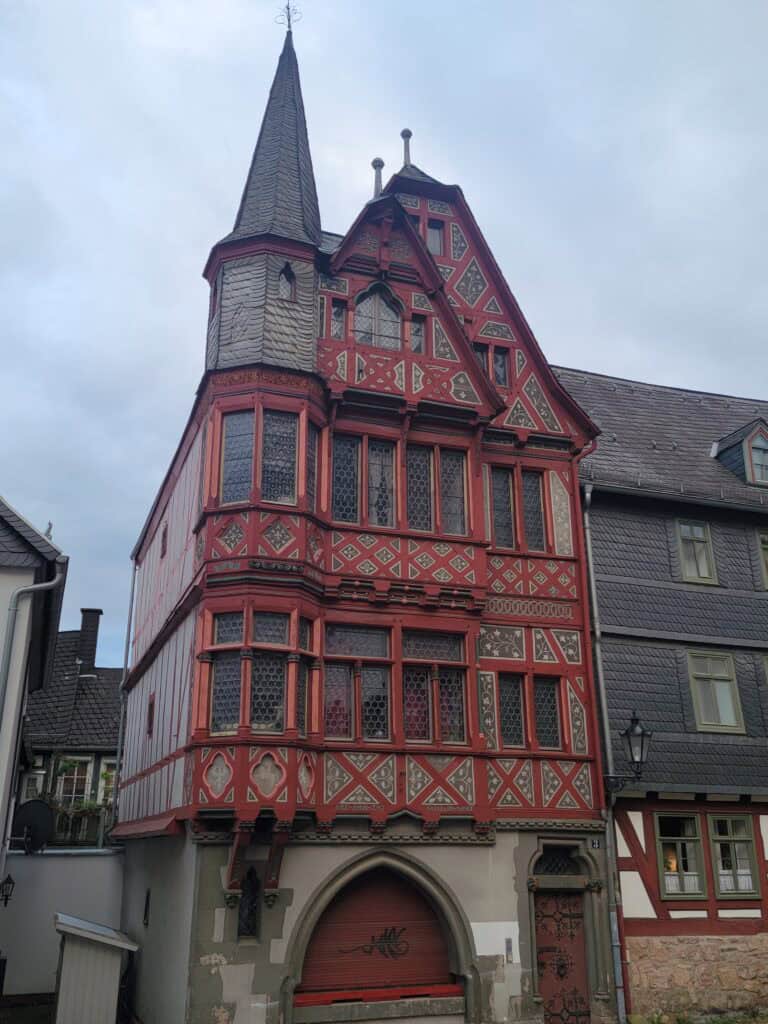
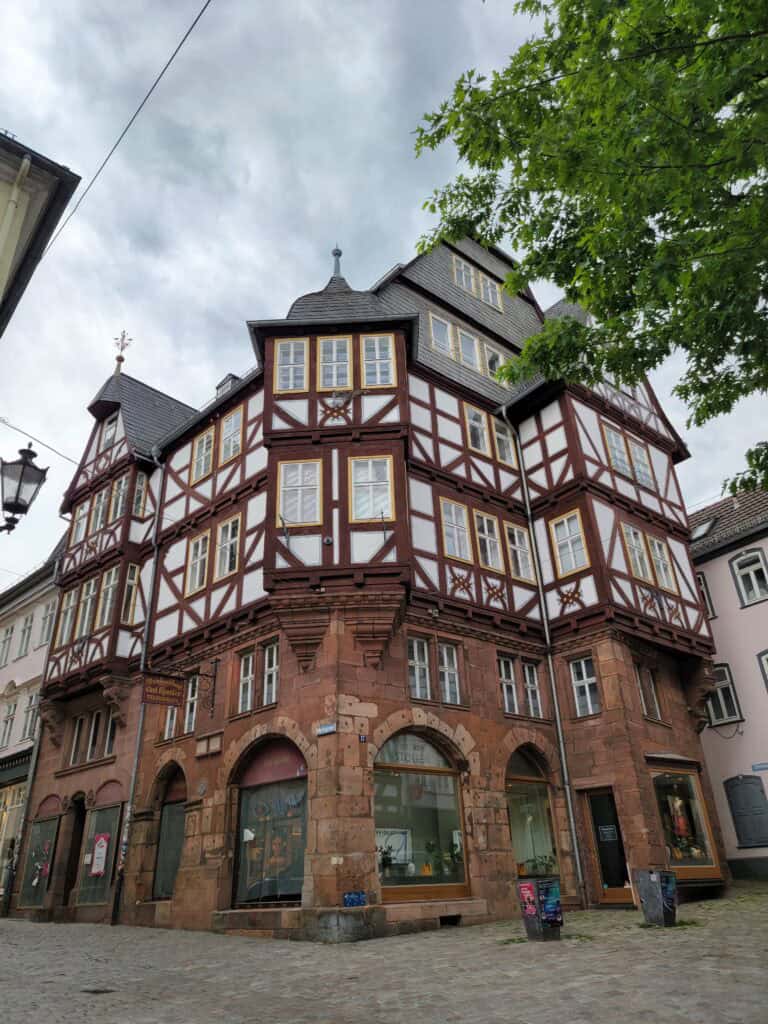
📍 Marburg’s Altstadt is a paradise for architecture lovers, and the Fachwerkhaus (Half-Timbered House) in the Town Square is one of its most famous buildings.
The iconic Fachwerkhaus sits at the heart of Marburg’s Market Square and is one of the best-preserved medieval houses in town. Today, it houses a cozy café where you can enjoy a coffee while soaking in 500+ years of history.
6. Explore Marburg’s Storybook Streets
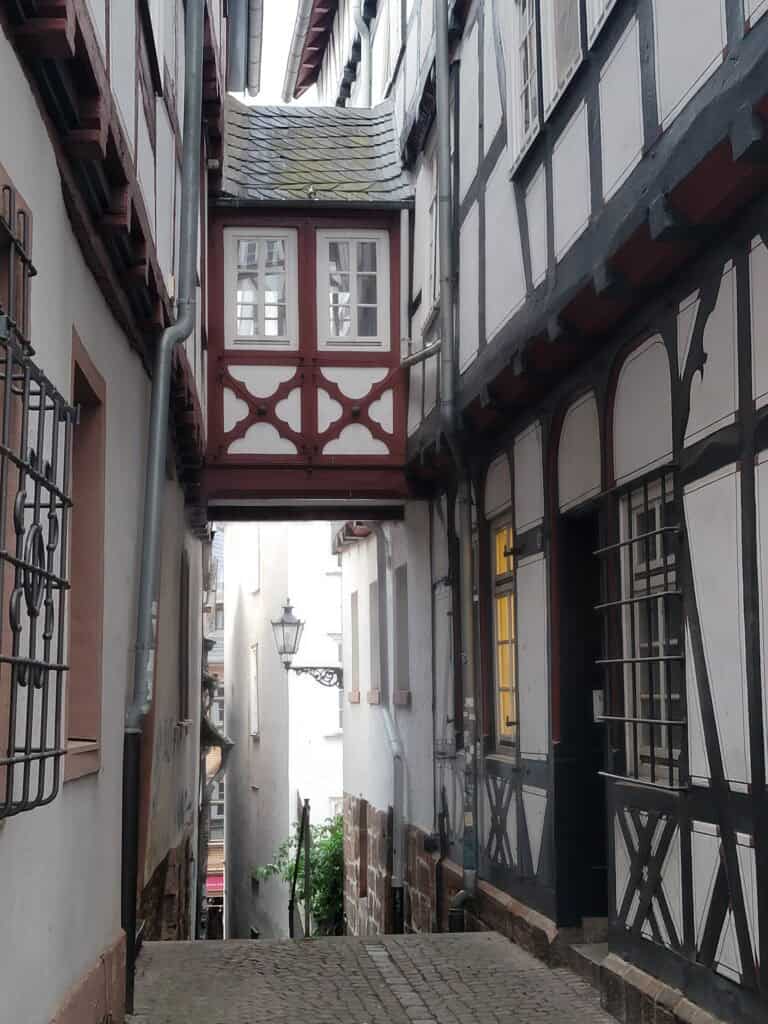
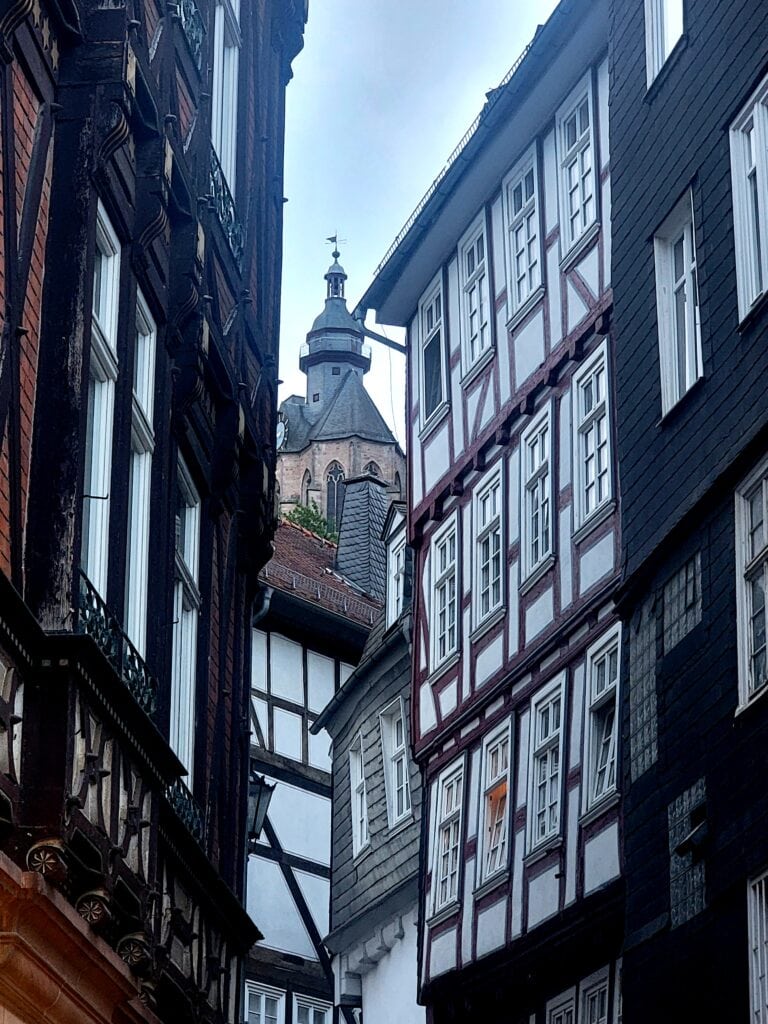

The Fachwerkhaus is just the beginning. The real magic of Marburg lies in wandering its crooked streets, discovering:
🏠 Dozens and dozens of half-timbered houses, each with unique carvings & colors.
🛤️ Hidden alleyways that feel like stepping back into the Middle Ages.
🏰 Breathtaking views of Marburg Castle towering above.
There are also buildings from later periods, and some are gorgeous as well, but the overwhelming sense in Marburg is that you’ve traveled back to the Mittelalter (Middle Ages).
🔗 Want the best views of Marburg? Climb up to the Castle Terrace for a picture-perfect panorama!
7. Zur Sonne: “The Coziest Tavern in Germany”
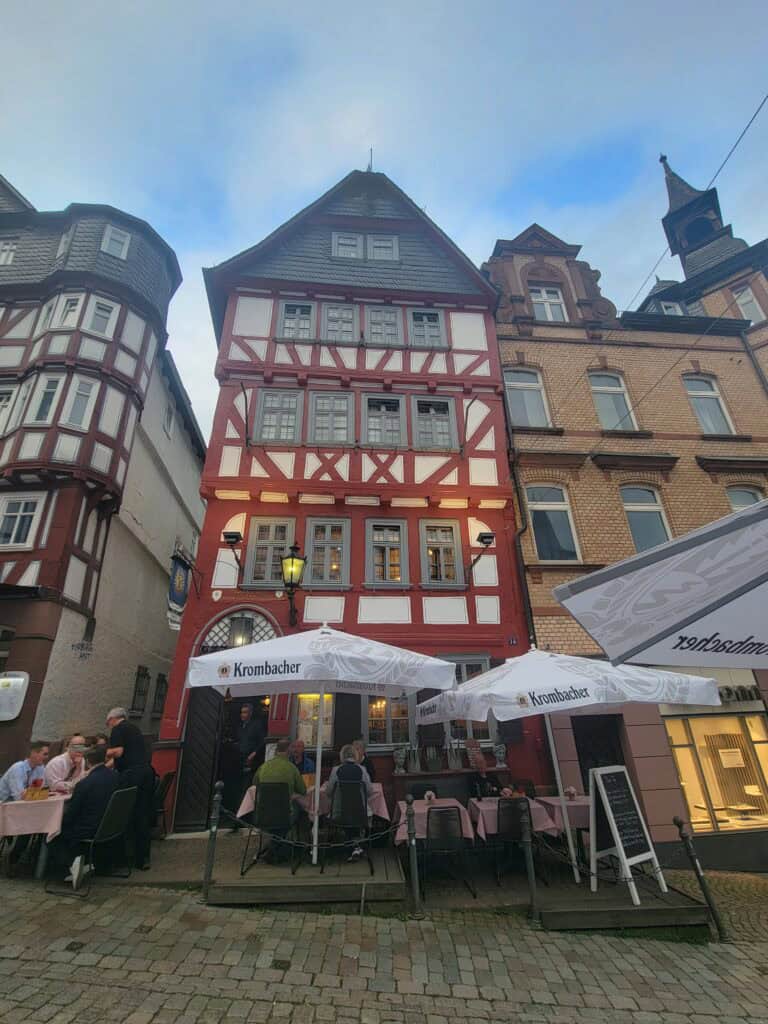

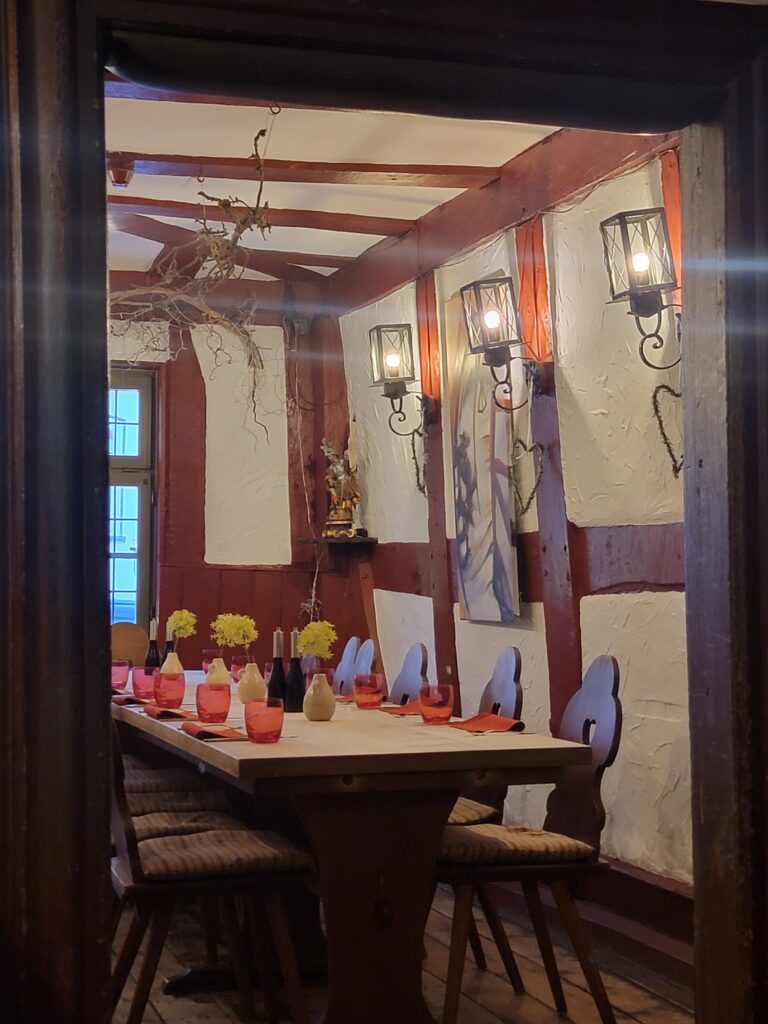
Speaking of gorgeous Medieval framework houses, right on the Market Square is a little eatery called Zur Sonne that’s been serving Marburgers and weary travelers for over 450 years! From 1569 to 1589 it only served bread and apple cider, but grew from there to become a thriving inn.
Later, the restaurant likes to say, the Brothers Grimm “stopped in for a merry drink,” in addition to many other notable scholars and professors from the university over the centuries.
🍻 Our Experience at Zur Sonne
We were lucky to visit during “Spargelzeit” (White Asparagus Season)—a big deal in Germany in the springtime! The spargel was fantastic, and we had the perfect seat by St. George’s Fountain, watching the golden rooster on the Town Hall clock crow every hour. We thoroughly enjoyed dinner here. There really is no better seat to take in the beautiful Marburg Altstadt.
Although we ate outside, we did go in to use the restroom and peeked around at the inside. There’s a reason Zur Sonne was voted “the coziest tavern in Germany!” When we come back to Marburg for its famous Christmas market, we’ll definitely stop in again “for a merry drink.”
8. St. Elizabeth’s Church: A Pilgrimage Site & Gothic Masterpiece
Elisabethstraße 3, 35037 Marburg
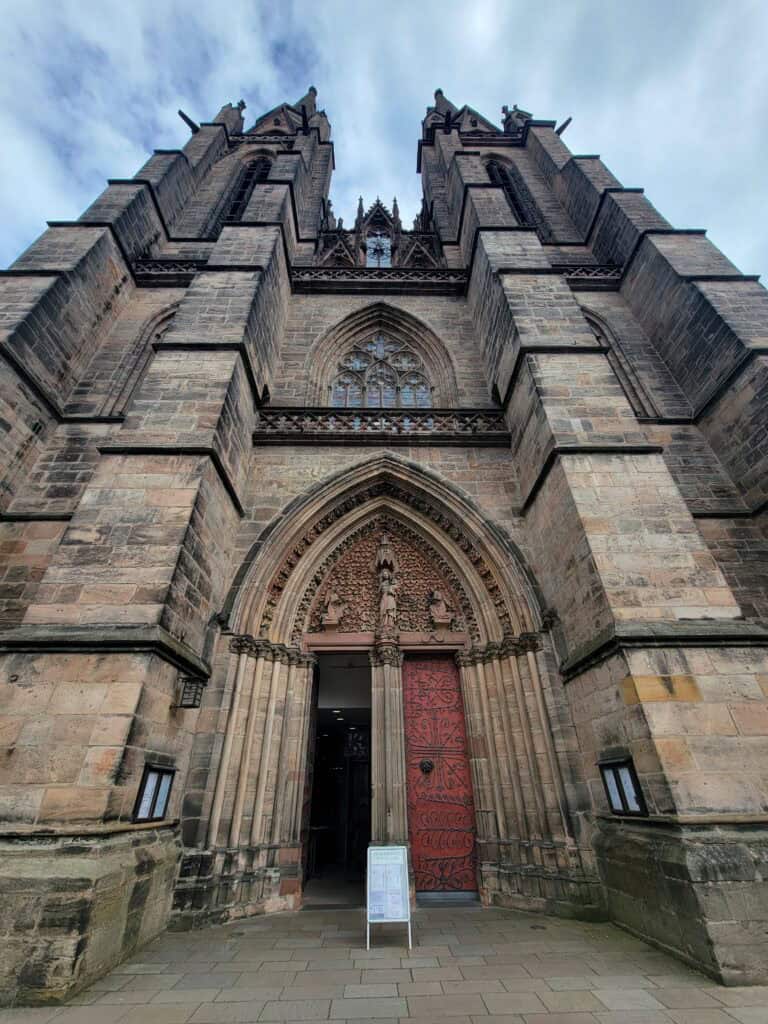
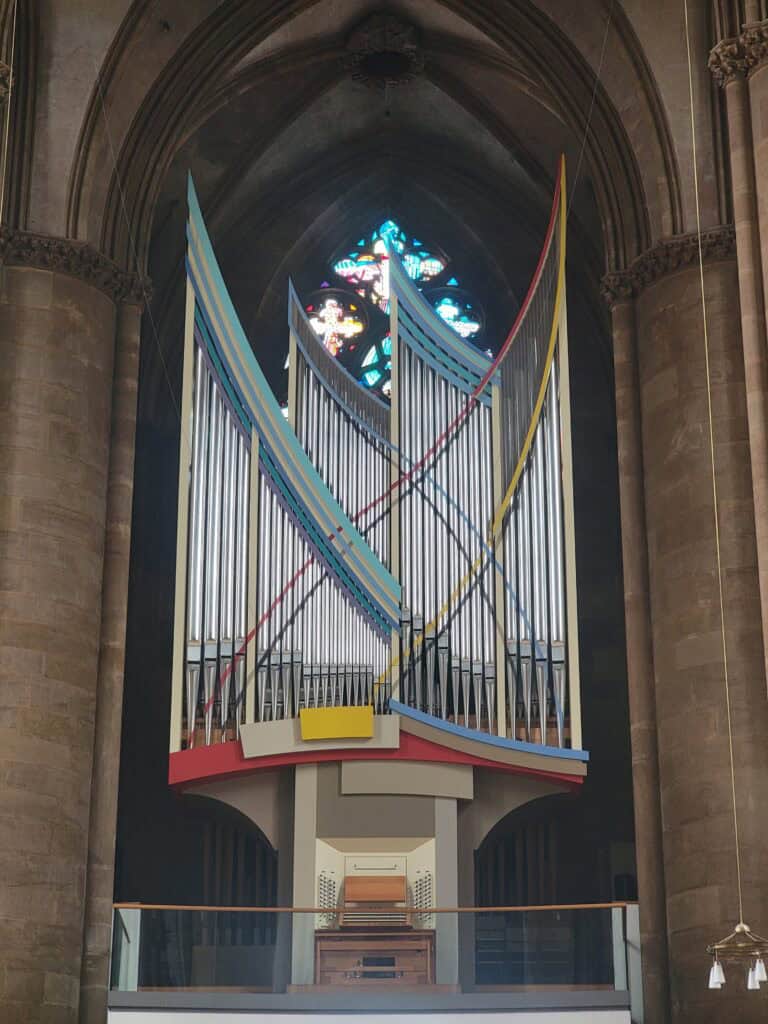
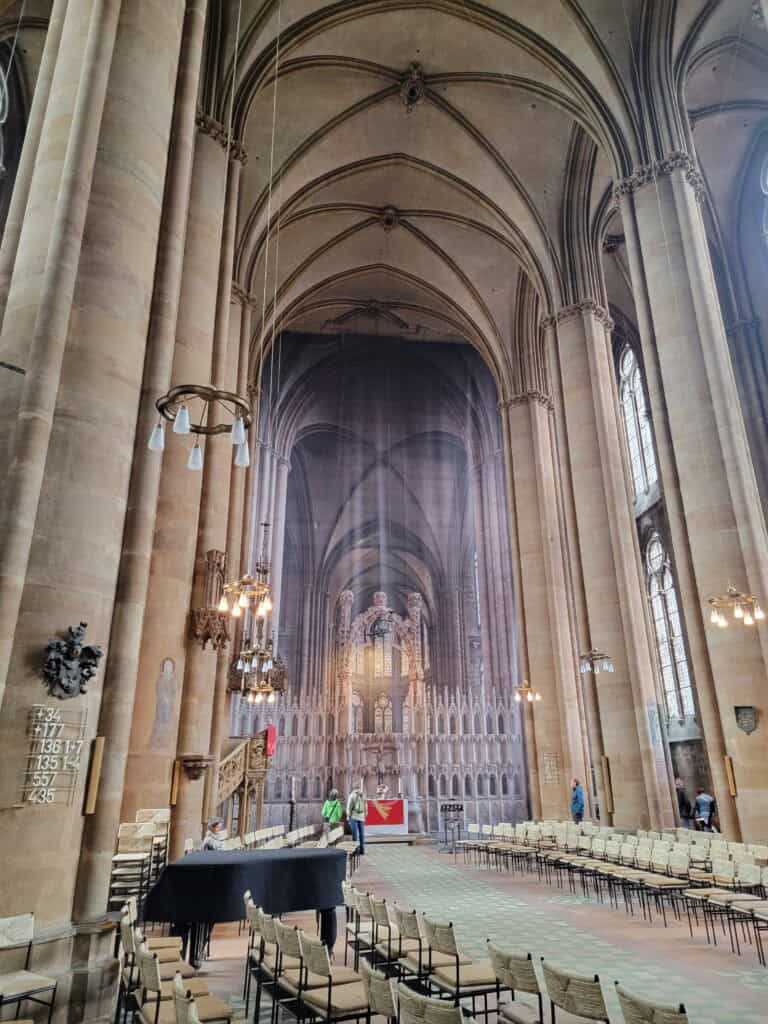
📍 One of the most important medieval churches in Germany, St. Elizabeth’s Church is a stunning Gothic cathedral built directly over the tomb of Saint Elizabeth of Hungary.
👑 The Life & Legacy of St. Elizabeth
I was really drawn to the noble and tragic story of St. Elizabeth, who was an extraordinary person and made a huge impact in the lives of her people during her short life.
Elizabeth was born a Hungarian princess and was married to Landgrave Ludwig of Thuringia when she was just 14 years old. But instead of embracing her new life of luxury, she dedicated her life to the poor and sick.
After her supportive husband Ludwig died, she was cast out of the royal court and founded a hospital where she personally cared for patients—an unheard-of act for nobility at the time. She died at just 24 years old, but her legacy as a saint and pioneer of compassionate care lives on.
💡 Did You Know? St. Elizabeth was canonized just four years after her death, making her one of the fastest-recognized saints in history!
🏗️ Renovation Update (2024-2027)
- A large-scale restoration project is underway, expected to last until 2027.
- You can still explore most of the church, but some areas are temporarily closed.
- Organ concerts are still happening! 🎶 Informal 30-minute concerts at 5 PM offer a chance to hear one of the most beautiful organs in Germany—check the church’s website for schedules.
🔗 Want to see where Elizabeth’s hospital once stood? The ruins of her medieval hospital are just across the street!
9. St. Elizabeth’s Hospital Ruin: A Medieval Legacy of Care
Pilgrimstein 1C, 35037 Marburg
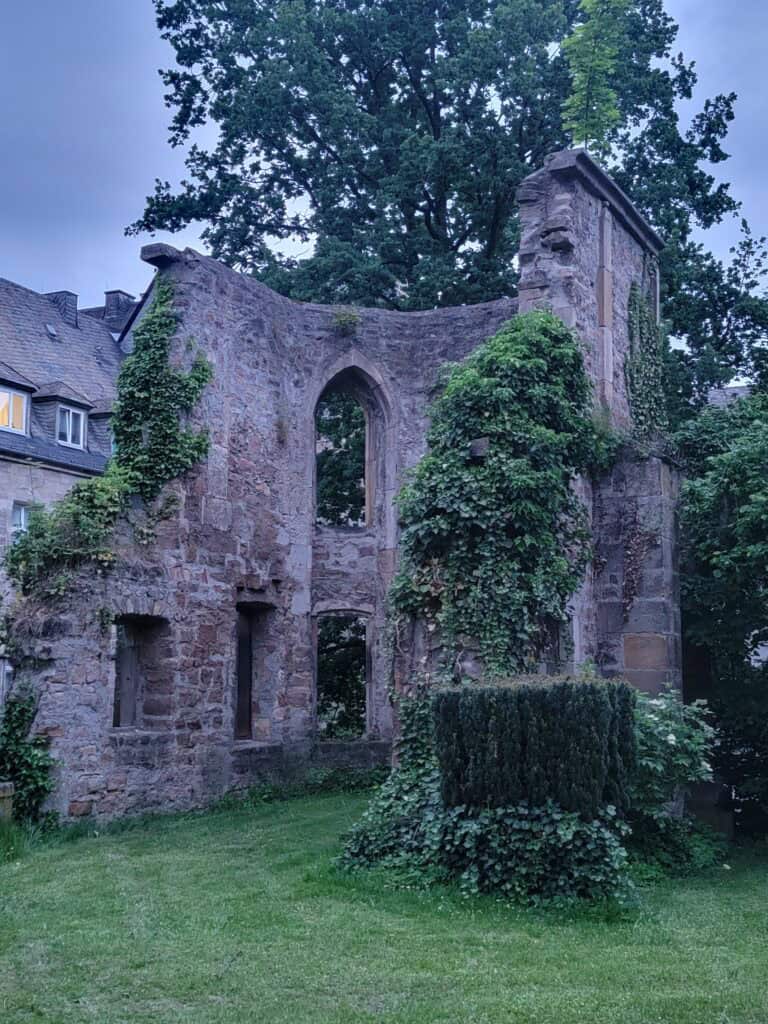
Elizabeth was a pioneer of medicine, and her hospital welcomed anyone who was sick regardless of their social status during a time when healthcare was available mostly for the privileged few.
Elizabeth herself, after taking her vow of voluntary poverty, played a hands-on role, tending to patients herself.
Her hospital continued to operate after her death, and became a model for health care reform.
🏗️ What’s Left of the Hospital?
- Only fragments of the hospital chapel’s choir walls remain, and are marked with a sign.
- The outline of the old hospital is visible in the paving stones surrounding the church.
10. Botanical Gardens: A Green Escape
📍 Marburg’s Botanical Gardens are a perfect place to relax, explore exotic plants, and start your journey along the Grimm Trail, which features sculptures inspired by Grimm’s Fairytales!
🌍 What to See in the Botanical Gardens
🌱 Rare Plants from Around the World – One of Germany’s oldest university gardens.
🏛️ 18th-Century Greenhouses – Home to a wide variety of tropical & medicinal plants.
🚫🐕 Important: Dogs are not allowed in the gardens!
You can check for the current opening hours and fees at their website.
11. The Old Synagogue: Medieval Jewish Life in Marburg
📍 Like many cities in Germany, Marburg’s Jewish history is marked by tragedy, resilience, and remembrance. This hidden gem in the Altstadt can be easily missed, so don’t miss it!
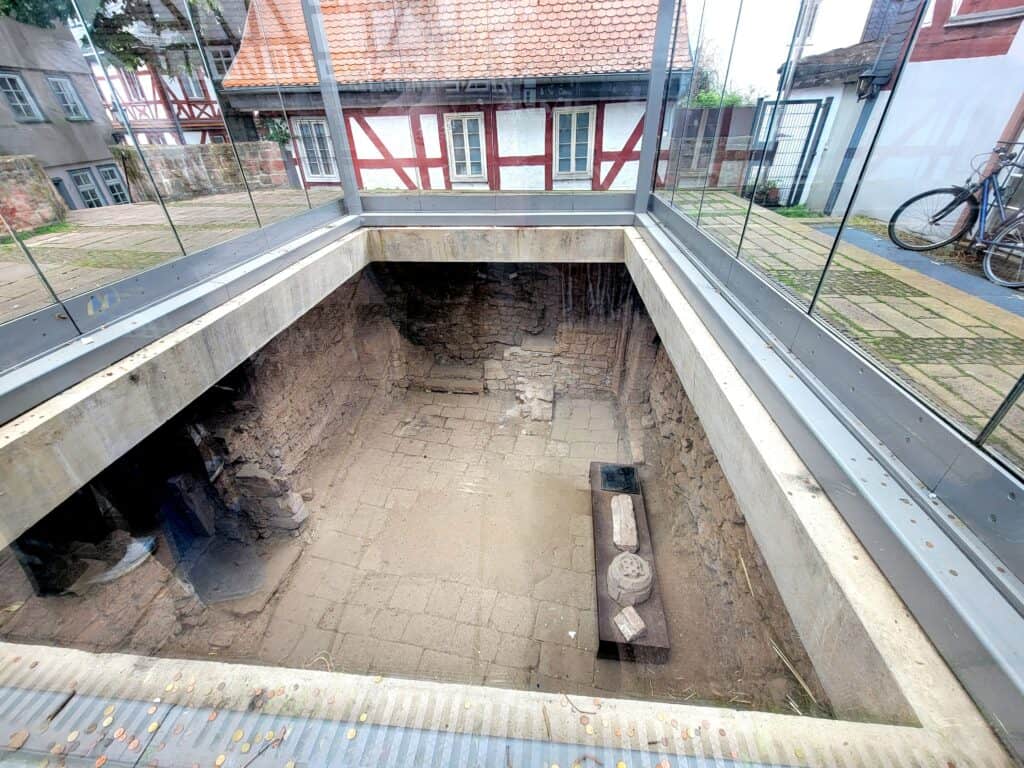
🔎 The Discovery of the Medieval Synagogue (1993)
Close to the Town Hall and the center of Old Marburg you will find the area that used to be the Jewish neighborhood. Like so many places in Germany the horrors of Medieval pogroms and the Holocaust are visible in memorials, tributes, and ruined synagogues.
In Marburg’s case, the remains of its oldest synagogue can be seen under a large glass cube. During construction work in 1993, the old foundation walls were discovered after being buried for 550 years. A vault keystone which has survived shows a Star of David. This synagogue was demolished in 1452.
12. The Garden of Remembrance: A Tribute to Lost Lives
Universitätsstraße 13, 35037 Marburg
📍 Another important site is the Garden of Remembrance, created by students in 1963 on the site of a synagogue destroyed on Kristallnacht (The Night of Broken Glass) in 1938.
The Garden of Remembrance, created by students in 1963 marks synagogue was burned to the ground by Hitler’s stormtroopers on Kristallnacht in November of 1938. On that day, hundreds of synagogues across Germany were demolished, along with Jewish businesses, homes, hospitals, and schools.
After the night of violence, many of Marburg’s Jewish citizens were transported to the Buchenwald concentration camp, or forced into ghetto housing. Most did not survive.
Jewish Life in Marburg Today
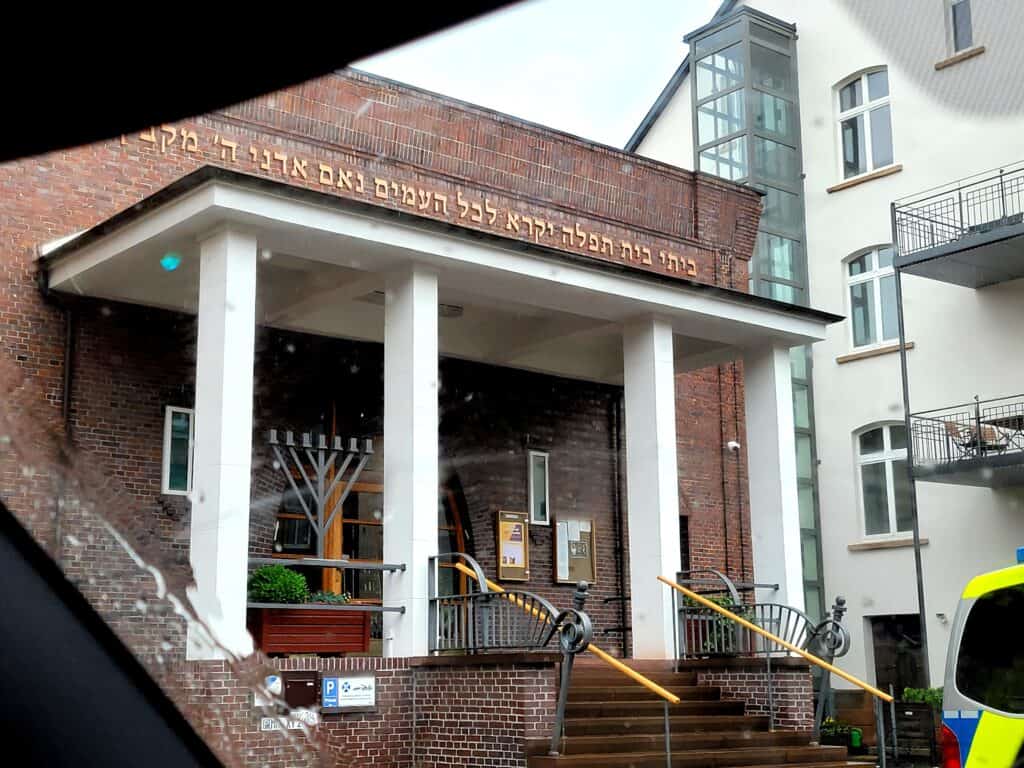
- After WWII, some Jewish families returned, though many emigrated to Israel.
- Today, Marburg has a new synagogue with 300+ members.
- Miraculously, the Torah scrolls from the destroyed synagogue survived and are now housed in the new synagogue.
🔗 Want to learn more? Visit the Jewish Museum in nearby Frankfurt for a deeper look into German-Jewish history in the region.
13. 🛡️ Marburg’s Coat of Arms: A Symbol of Medieval Power
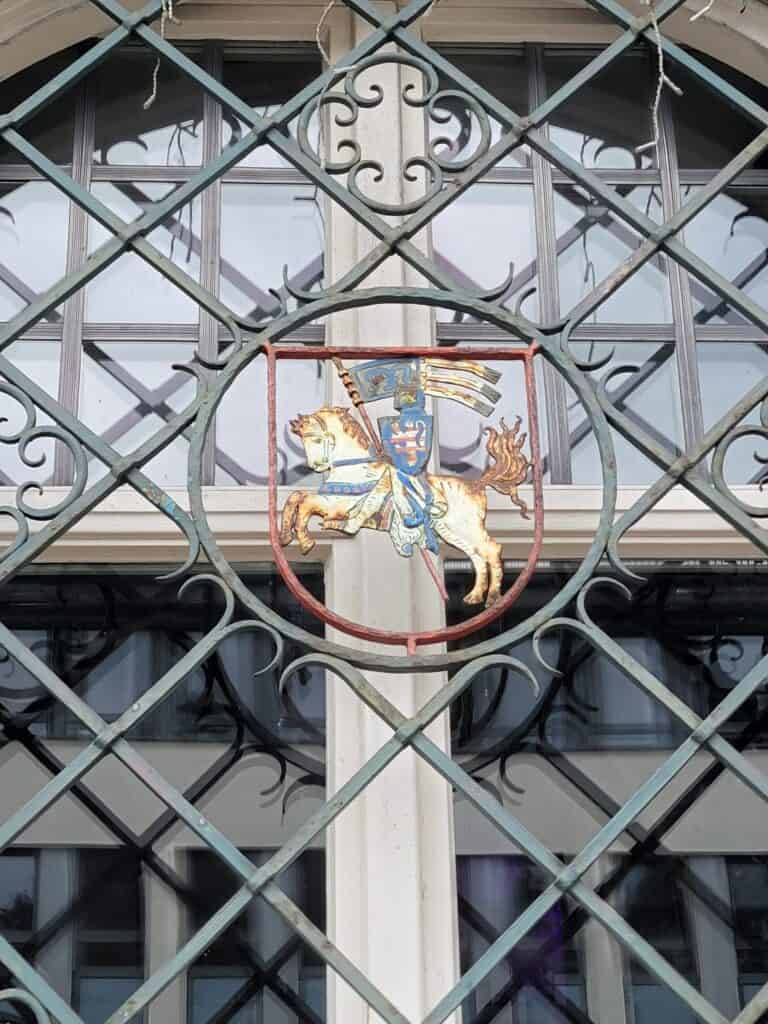
📍 What better coat of arms for Marburg could there be than a knight on horseback? This heraldic emblem can be seen in many places around the town. Keep your eye out!
🔎 Where to Spot the Coat of Arms
🏛️ Town Hall (Rathaus) – The oldest version of the emblem is carved above the entrance.
🏰 Marburg Castle Museum – Find historic artifacts featuring the coat of arms.
📜 Official Town Signage – Many municipal buildings and documents bear the emblem.
💡 Did You Know? The “M” on the knight’s flag was a late 19th-century addition—it wasn’t originally part of the medieval design! And yep, it stands for “Marburg!”
14. The Grimmdichpfad (Grimm Path)
📍 Following the “Grimm Path” is one of the most quirky and delightful things to do in Marburg, and is a great way to explore the town while continuing the Brothers Grimm fairy tale theme. Every single installation is a hidden gem.
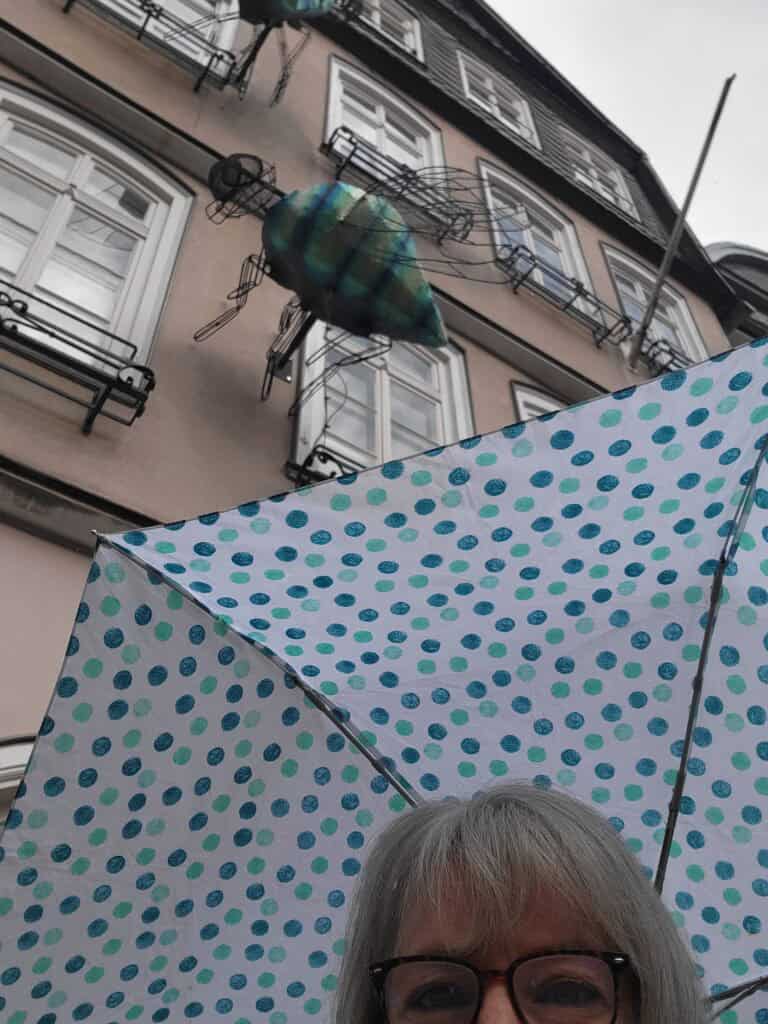

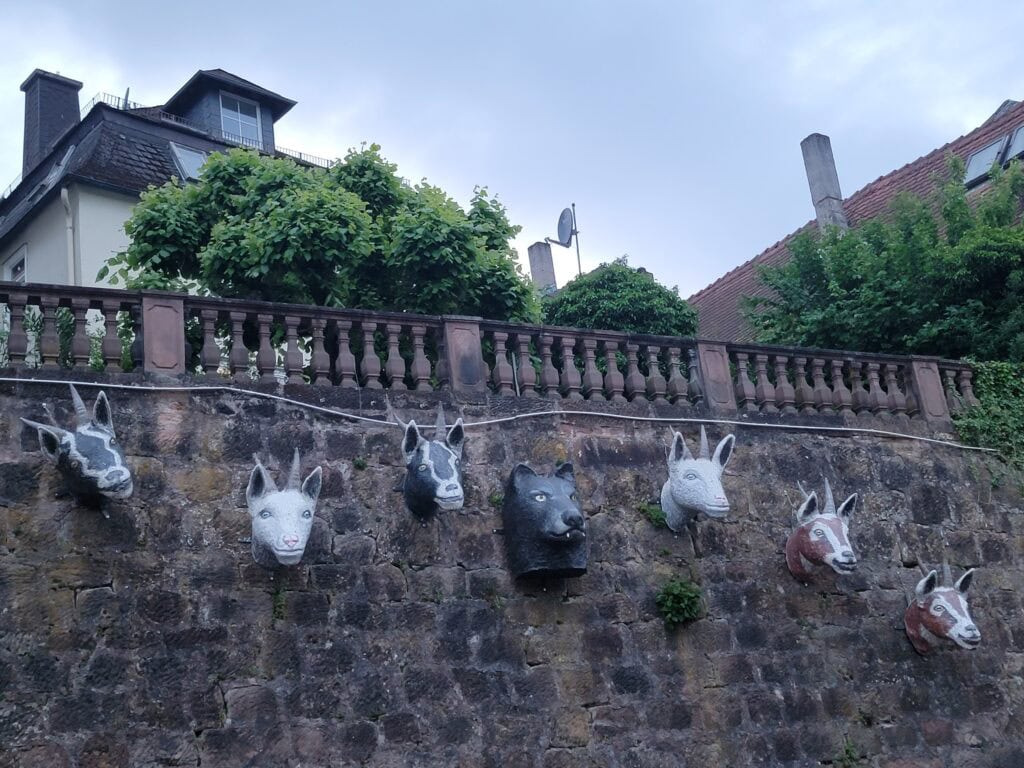
🧚♂️ The Grimmdichpfad: Follow Marburg’s Fairytale Trail
We absolutely loved this magical self-guided tour of Marburg. As we followed the Grimmdichpfad (Grimm Path), a whimsical trail that leads past landmarks, hidden gems, and Brothers Grimm-inspired art installations it felt like a treasure hunt.
We definitely let out our inner children as we spotted all the fairy tale sculptures, some in unlikely places!
📌 Highlights of the Grimm Path
🛤️ Follows a 1-mile route through Marburg’s Old Town & Castle Hill.
🎨 Features sculptures & murals representing Grimm’s fairytales.
📜 Every stop has a sign with story details & historical context.
If you don’t mind the spoiler, you can see all the fairytales represented at the waypoints here.
✅ For the ultimate Marburg experience, explore all the history and hidden gems of Marburg with this private customizable walking tour! 👑
15) 📖 Pick Up a Copy of Grimm’s Fairytales!
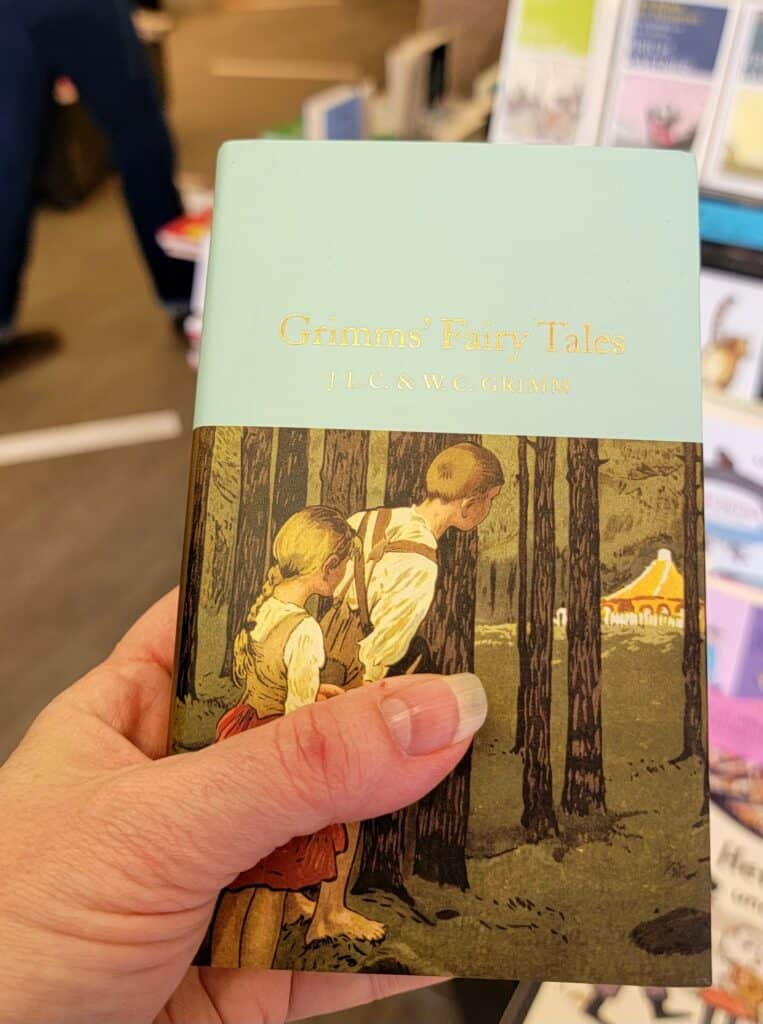
While following the Grimm Path, stop by one of Marburg’s charming bookshops to grab a copy of the Brothers Grimm’s classic fairytales. How can you not? I bought mine right next to the Rathaus—the perfect literary souvenir!
🍽️ Our Favorite Restaurants in Marburg Altstadt
16) 🥘 Restaurant Ratsschänke: Historic Dining in the Town Square
📍 Located just steps from the Rathaus, Restaurant Ratsschänke offers classic Hessian cuisine in a charming medieval setting.
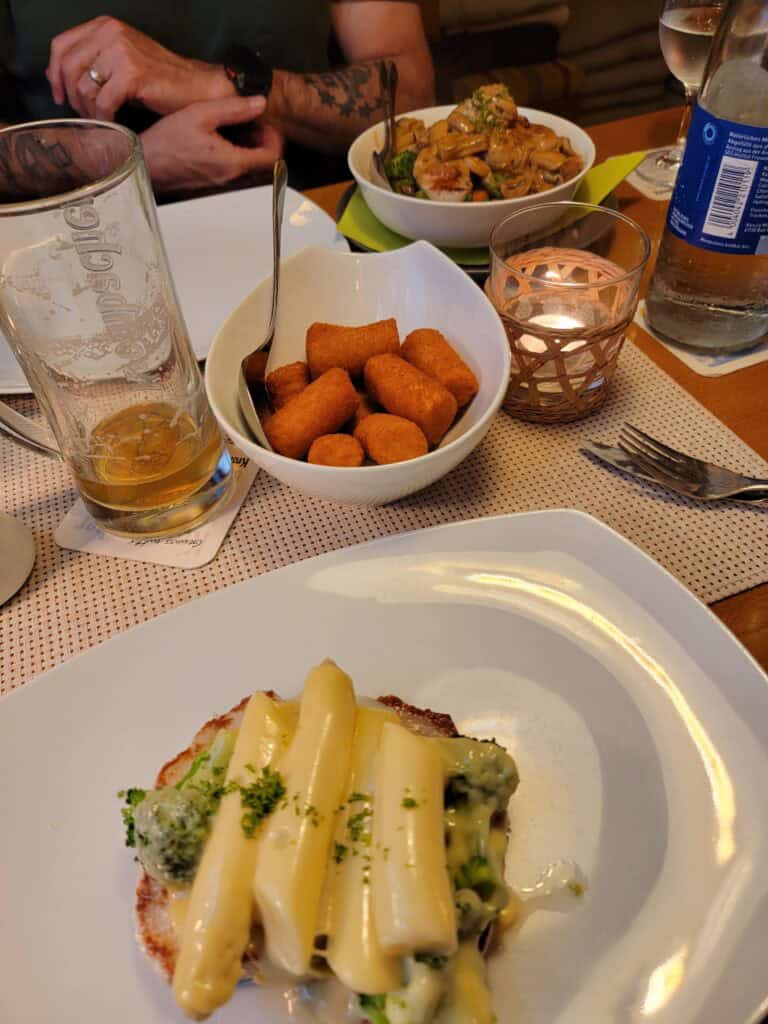
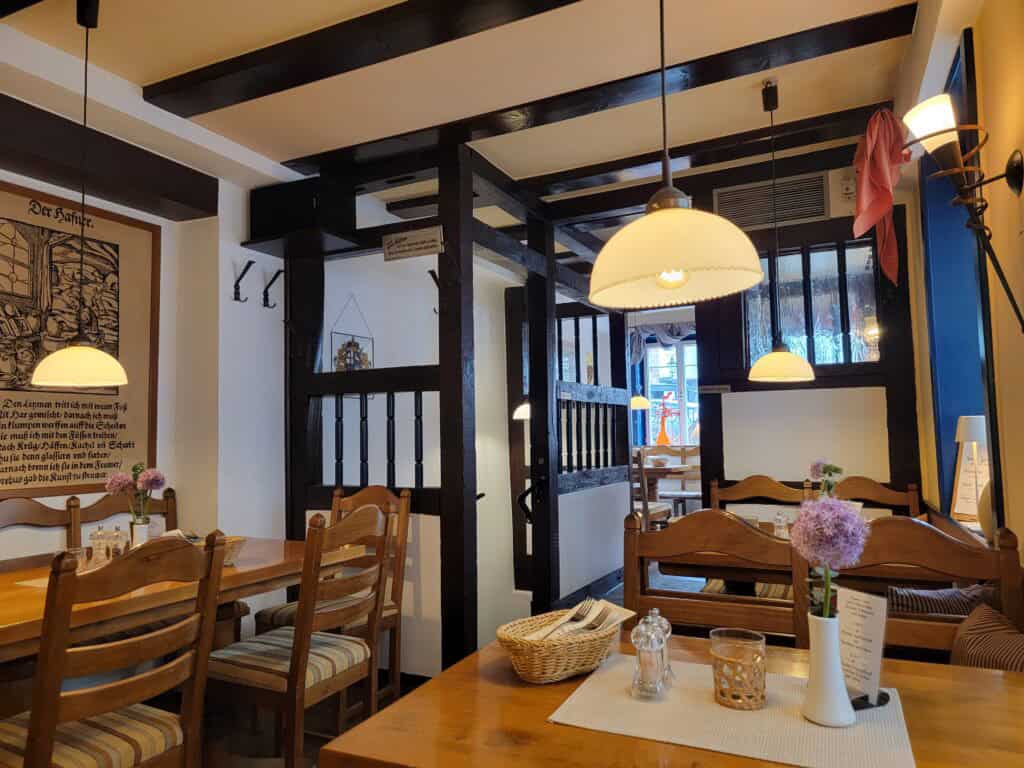
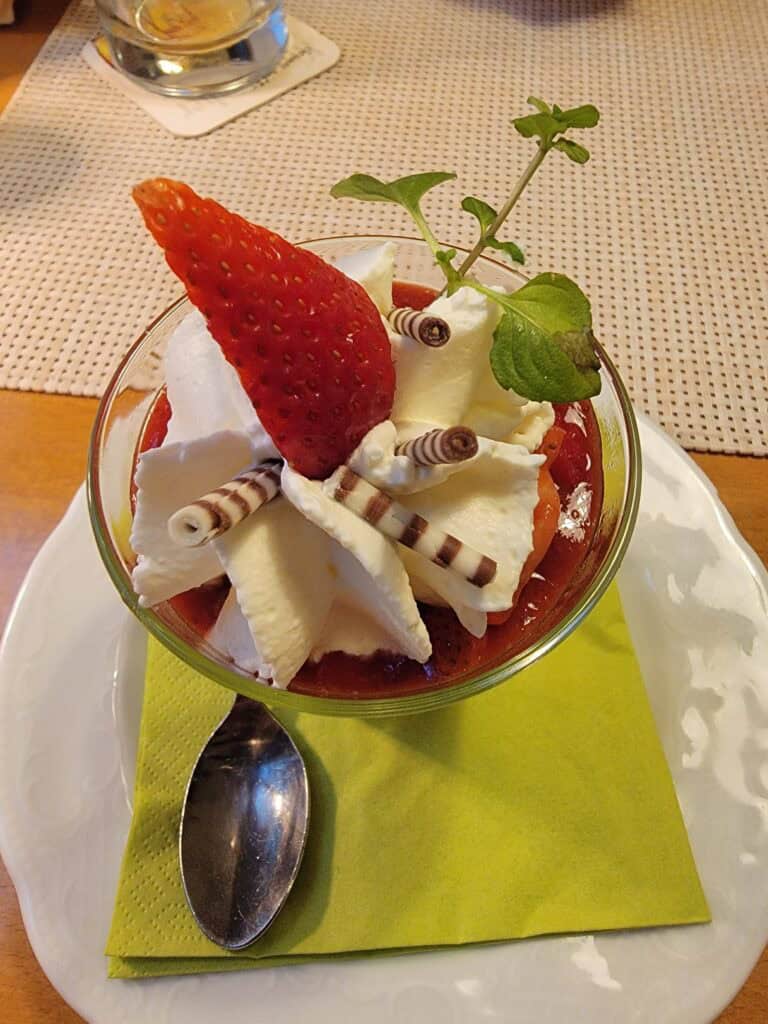
🍴 What to Try
🥩 Pork loin with white asparagus (Spargel) – A seasonal German favorite.
🍄 Pork stew with mushroom gravy – Rich, hearty, and flavorful comfort food.
🍰 Homemade desserts – A perfect sweet ending to your meal.
This was our favorite meal in Marburg. We passed by and peeked in the window and knew we had to eat there. We weren’t able to get reservations that day, but we did for the next night and we were so glad we did!
The service felt totally family-style, and our intimate little nook couldn’t have been more charming.
💡 Tip: This tiny little restaurant books up fast, so make a reservation in advance!
📞 Reserve by phone or check days of operation & menu. They do speak English!
17) ☕ Café am Markt: “Where Breakfast Never Ends”


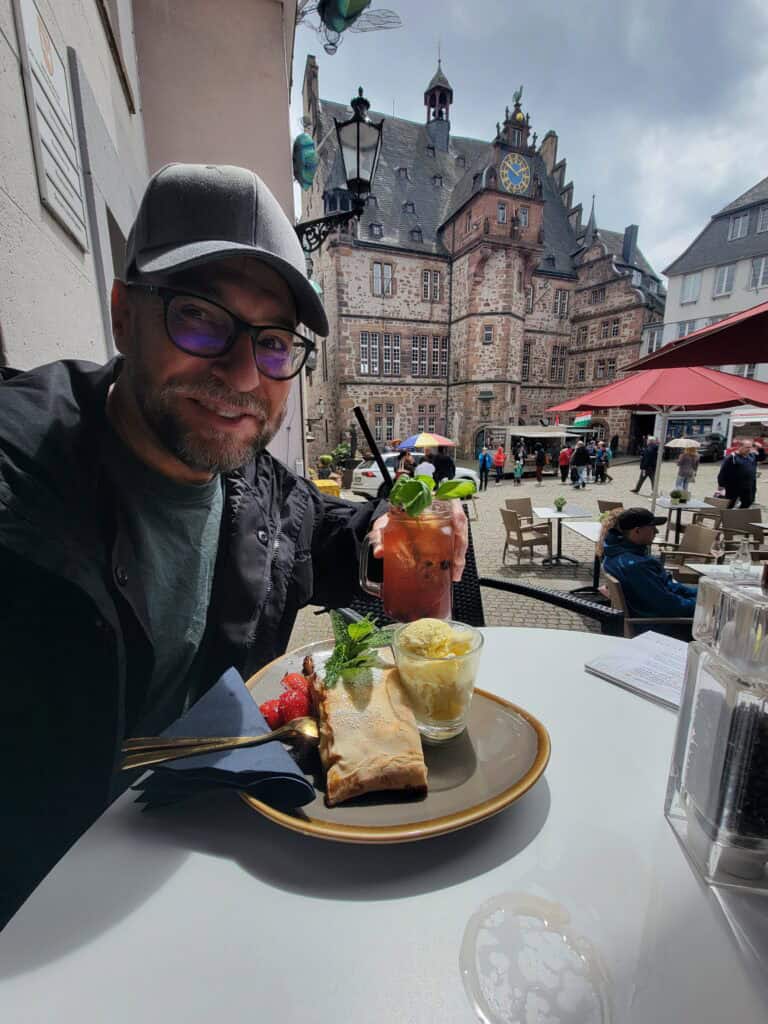
📍 Café am Markt is famous for all-day breakfast, fresh pastries, and traditional German Flammkuchen right next to the historic Town Hall in the Market Square.
🍽️ What to Order
🥞 German pancakes – A local favorite, always on the menu!
🥖 Flammkuchen with pears, walnuts & goat cheese – A must-try. Absolutely divine!
🍎 Homemade apple strudel & ice cream – Perfectly sweet & comforting.
💡 Tip: Check out their Sunday brunch specials—they’re a local favorite! And sit outside during warm months for the best view of the Town Hall and its famous clock!
📜 View their full English menu
18. 🍑🍺 Try Marburg’s Unique Peach Beer!
📍 For a true Marburg specialty, try the local Peach Beer—served with an actual peach inside! 🍑🍺
🍻 Where to Find It
- Available in select local pubs & bars—ask a bartender!
- Pairs perfectly with traditional Hessian food and sweets
19) Take an Elevator Between the Upper and Lower City
Pilgrimstein 28A, 35037 Marburg
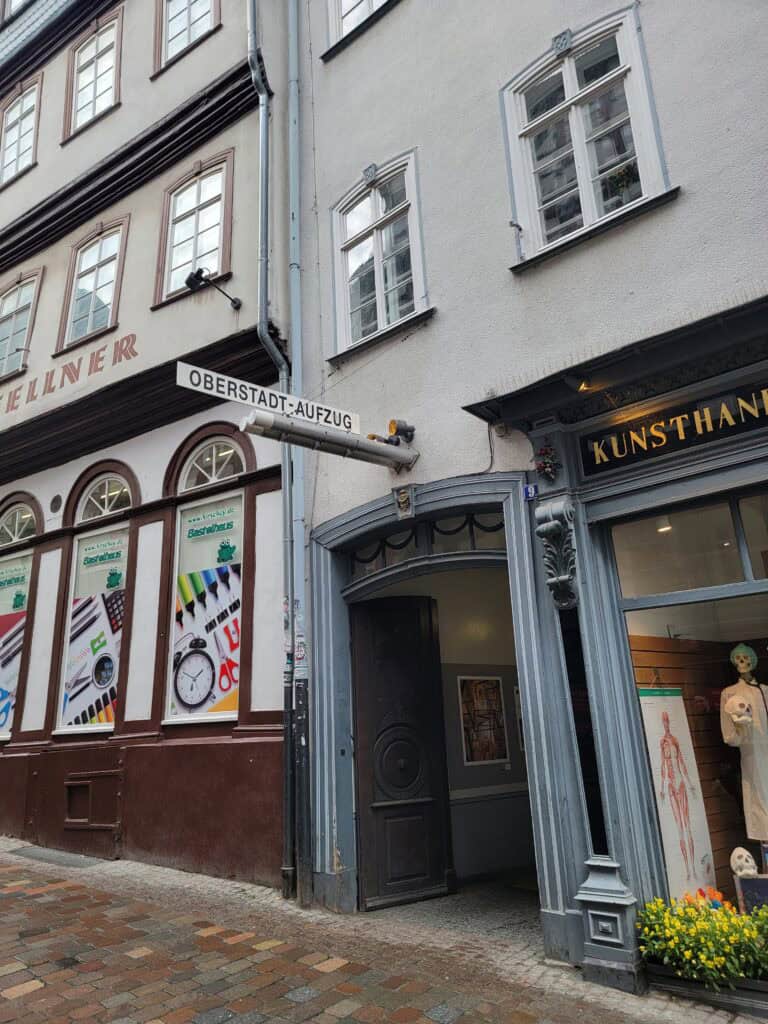
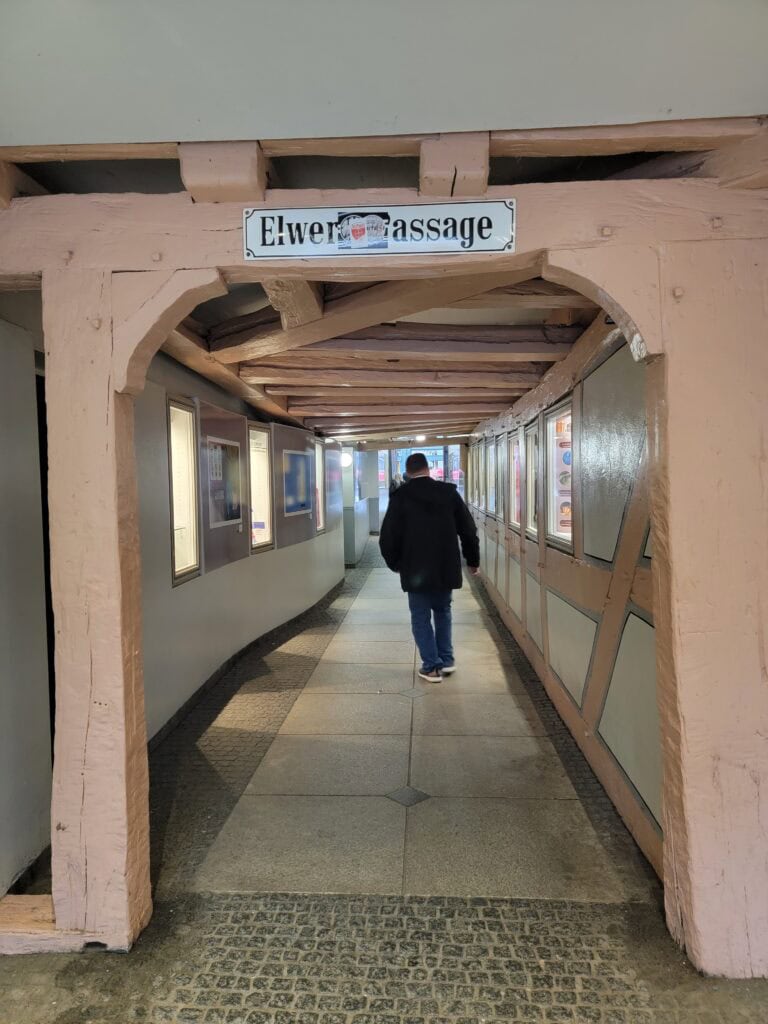
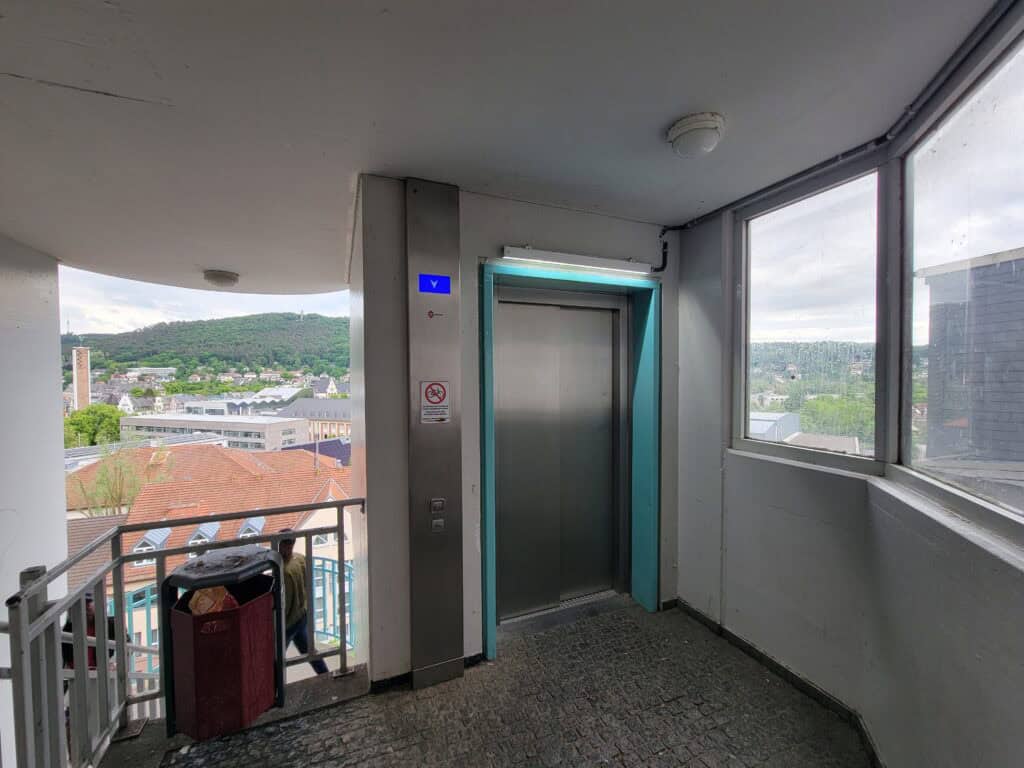
The Elevator Connecting Upper & Lower Marburg is a fun little experience. And it definitely saves you a lot of climbing! See if you can find it down the little covered alleyway!
Marburg is divided into upper (Altstadt) and lower (Newer city) and it’s very convenient if your hotel is in the lower part of the city and all the places you want to be are in the upper part!
Even if you don’t use the elevator, there’s a great view from the waiting area.
20) A Last Look at Quirky Things to Do in Marburg
📍 Beyond its medieval charm, Marburg is full of quirky surprises —so keep an eye out for these hidden gems!
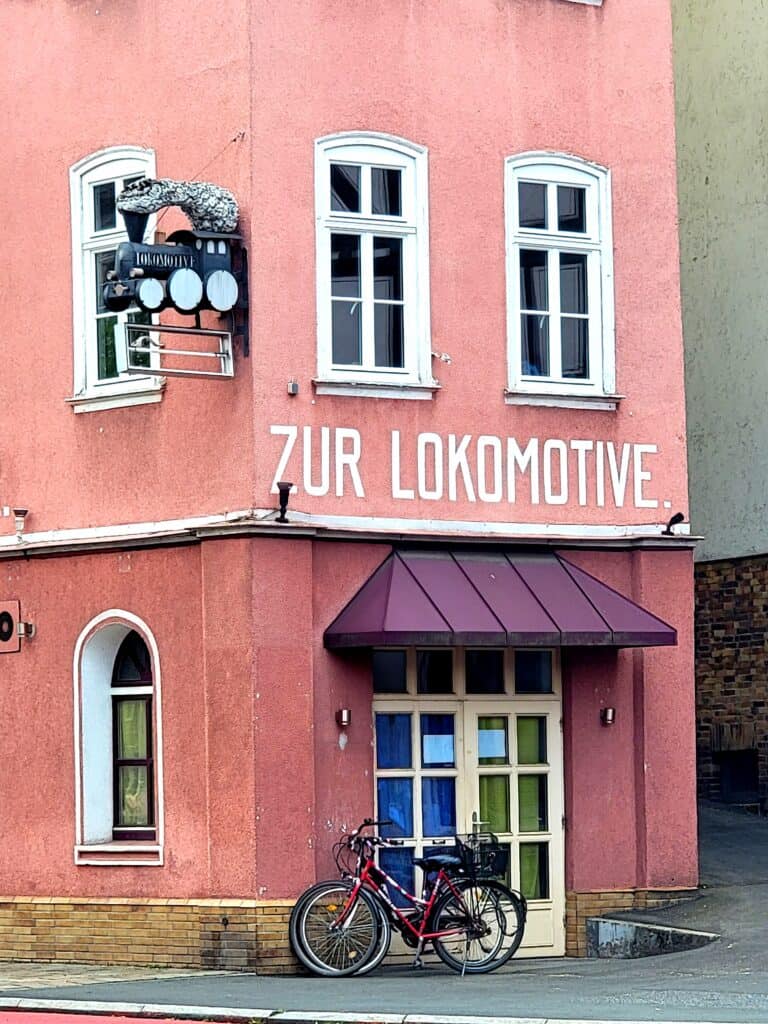
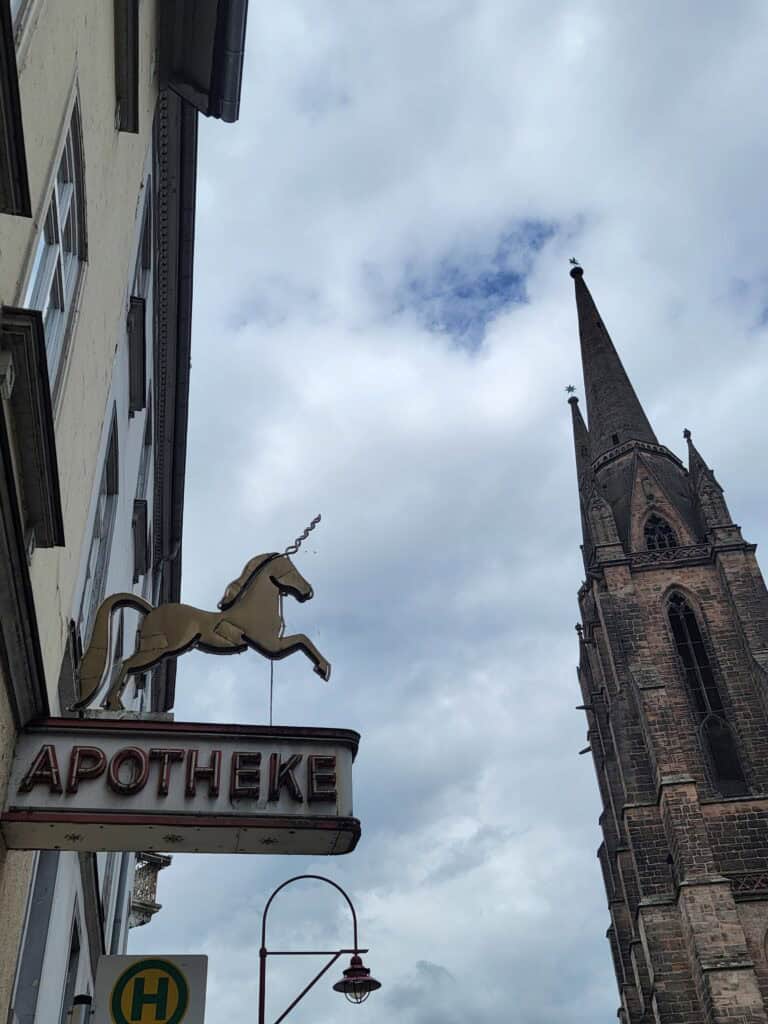


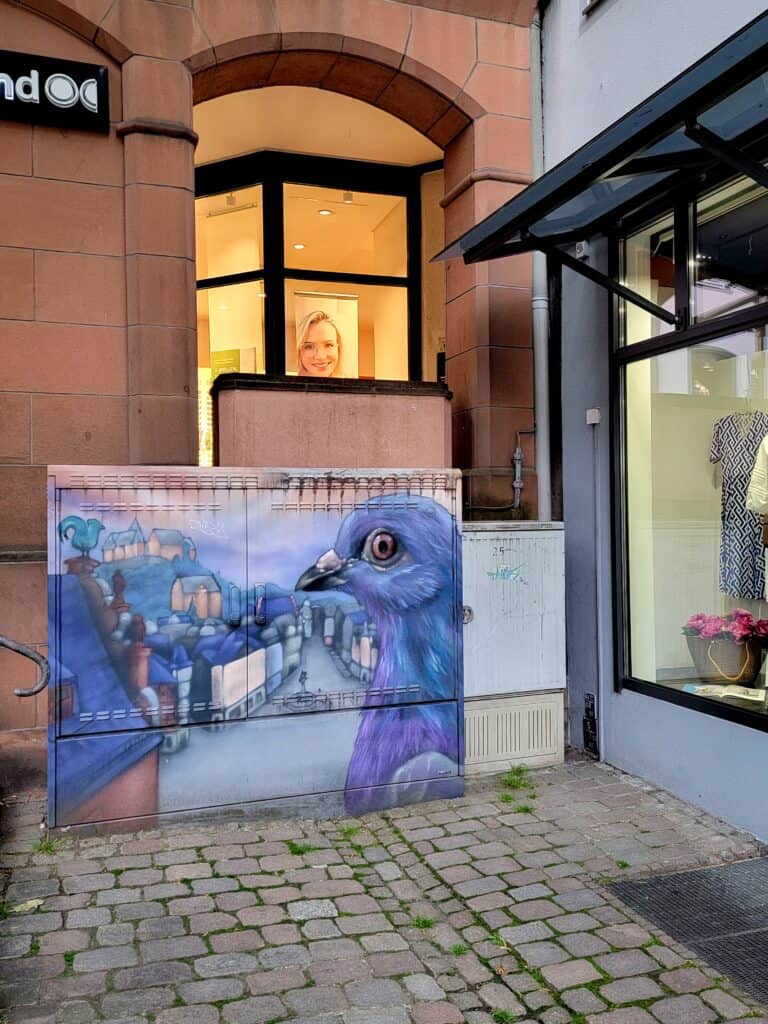
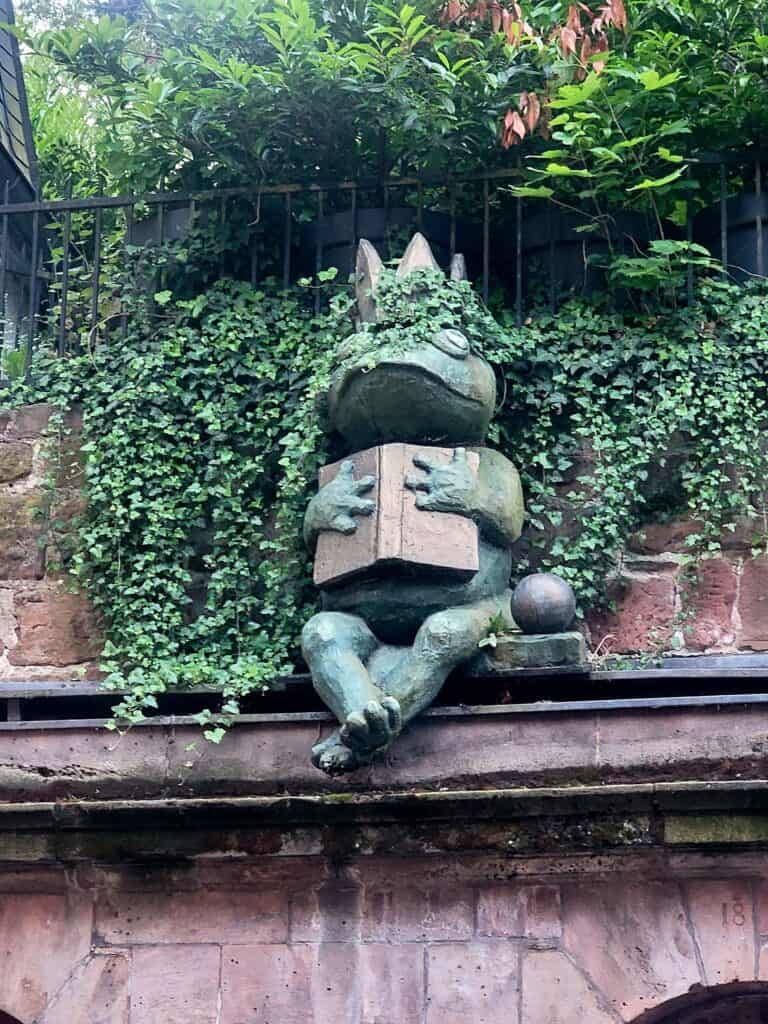
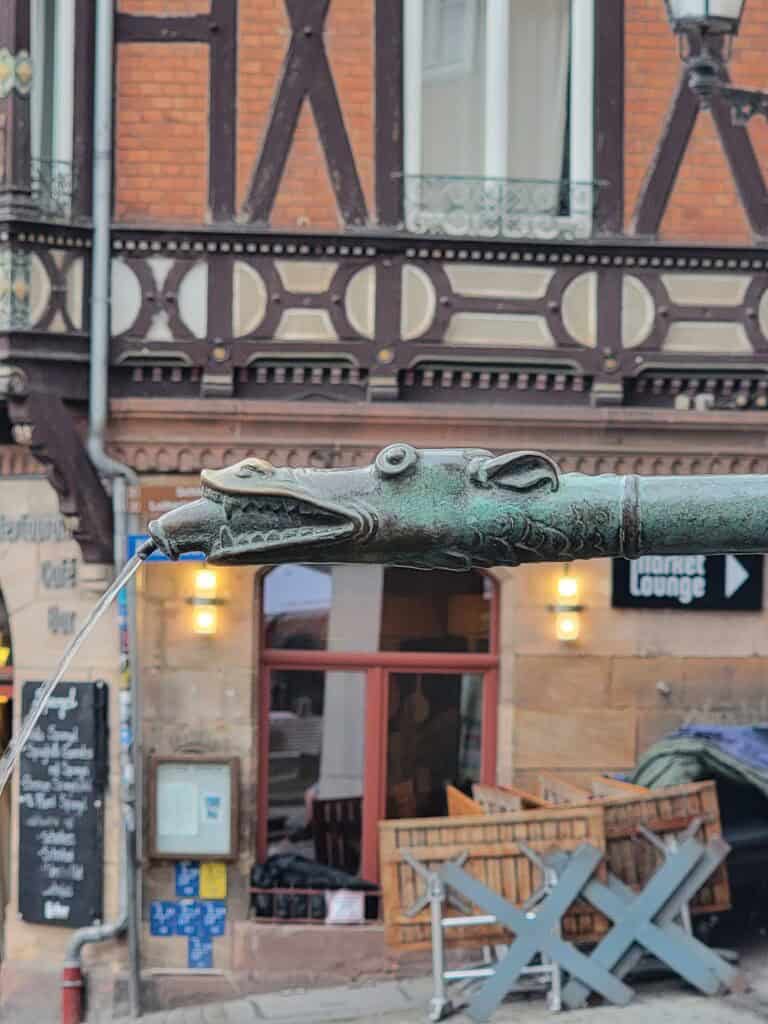
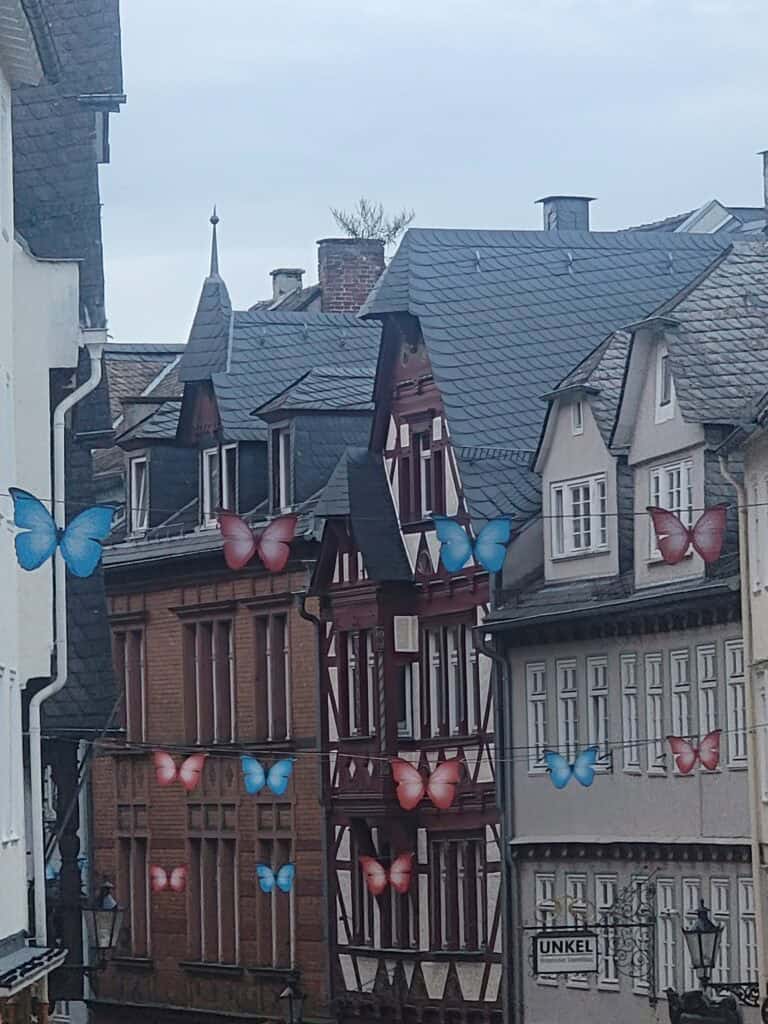
🔎 Fun & Unexpected Finds
🐉 Dragon-themed fountains & gargoyles
🐸👑 The Frog Prince is Everywhere!
🦄 The Unicorn Pharmacy – A real medieval shop!
🚂 Zur Locomotive with a train crashing through the facade!
🚦 Unique traffic signals featuring adorable designs.
✅ We hope this guide to the best things to do in Marburg has inspired your trip! Have any questions? Drop them in the comments! 👇
Where to Stay in Marburg With (or Without) a Dog
🏡 Welcome Hotel Marburg: A Perfect Central Stay
📍 Located at the base of the elevator to the Old Town, the Welcome Hotel Marburg is an excellent choice for visitors looking for comfort, convenience, and dog-friendly accommodation.
🏨 Why Stay Here?
✔️ Dog-friendly & pet-welcoming 🐶
✔️ Quiet, clean rooms with great amenities
✔️ Fantastic breakfast buffet 🍳
✔️ Secure on-site parking 🚗
📖 Read our full review & book your stay here.
Getting to Marburg: Transportation Guide
📍 Marburg is well-connected by train, car, and nearby airports. Here’s how to get there:
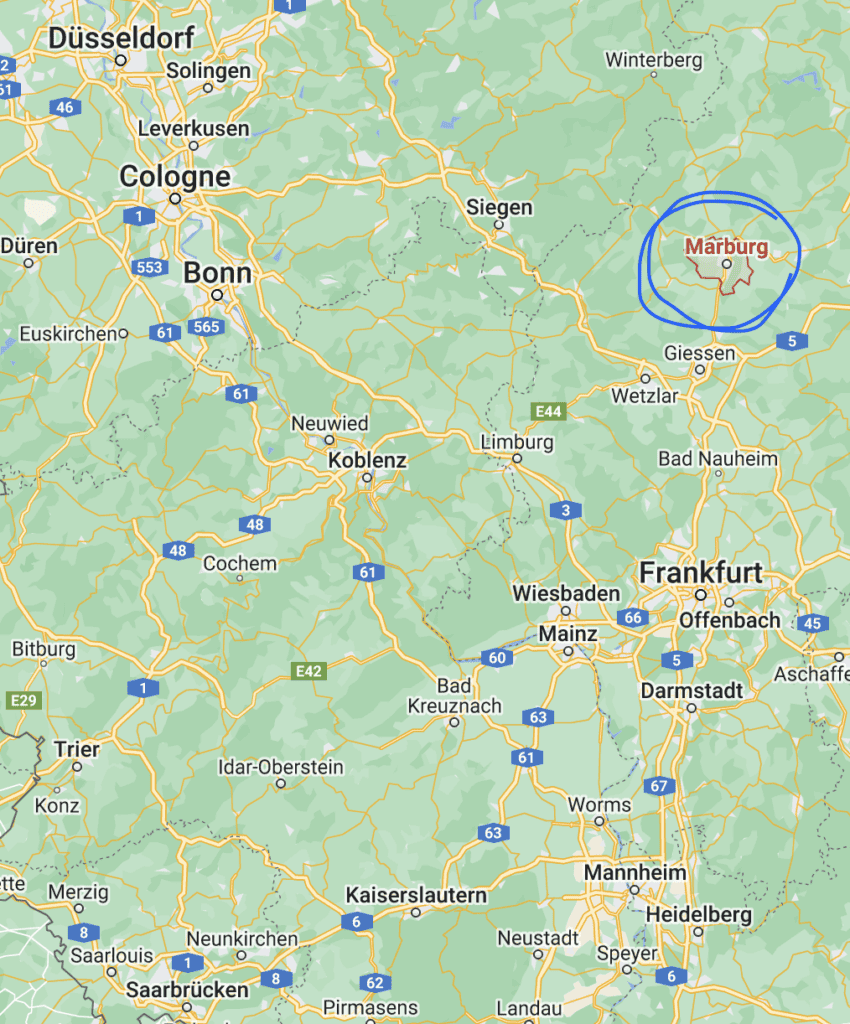
🚗 By car
- Frankfurt Airport – About 55 minutes (96km)
- Kaiserslautern – About 2 hours 10 minutes (203km)
- Heidelberg – About 1 hour 45 minutes (173km)
- Wiesbaden – About 1 hour 15 minutes (116km)
- Cologne – About 2 hours 10 minutes (188km)
🚉 By train
- Frankfurt am Main – About 1 hour 5 minutes
- Kaiserslautern – About 3 hours 30 minutes
- Heidelberg – About 2 hours 5 minutes
- Wiesbaden – About 2 hours 9 minutes
- Cologne – About 2 hours 55 minutes via Frankfurt am Main
✈️ Nearest airport
Frankfurt International Airport
You may also like these posts about other fabulous castles and castle ruins in the area!
- Welcome Hotel Marburg Review: Discover Dog-friendly Charm
- Best Messel Fossil Itinerary: 1 Day, 3 Stops, All the Highlights
- Your Ultimate Guide to Visiting Nuremberg Castle: History, Tips & Must-Sees
- Explore the Astounding Schlossberg Caves and Castle Ruins in Homburg
- Ultimate Guide to Frankenstein Castle in Frankenstein Germany
- Hike to Hohenecker Castle in Kaiserslautern Germany
- Explore Fascinating Nanstein Castle in Landstuhl Germany
- Stahleck Castle in Bacharach: A Gorgeous Hike with a Dark Past
- Discover Charming Hohenbaden Castle Overlooking Baden-Baden
- A Real-Life Fairytale Castle in Germany – Discover Miraculous Burg Eltz
- Saarbrücken Castle – Discover this Fascinating Underground World
- 28 Best Day Trips from Kaiserslautern: Your Ultimate Guide
More City Guides to Hidden Gems in Europe
- 25 Best Things to Do in Nuremberg: History and Hidden Gems
- 46 Best Things to Do in Rothenburg ob der Tauber
- One Day in Bamberg: Best Guide to Germany’s Medieval Beer Capital
- 21 Best Things to Do in Kaiserslautern Germany
- 10 Best Things to Do in Reims France
- 11 Best Things to Do in Trier, Germany
- One Day in Aachen? Discover the Treasure!1
- The Perfect Weekend in Cologne, Germany
- The 12 Best Things to Do in Epernay France
- 12 Incredible Things to See in Metz, France
- Ostuni the White City: Your Magical Gateway to Puglia
- The 7 Most Amazing Things to Do in Ravello Italy
- Is Pisa Worth Visiting? The Good and the Bad.
- Ravenna, Italy – Ultimate One-Day Itinerary!
- 20 Amazing Things to Do in Poznan, Poland!
- Altdorf Switzerland: Discover Where William Tell Shot the Legendary Apple
